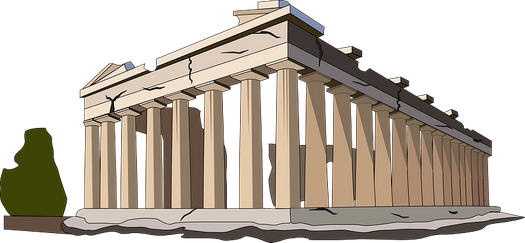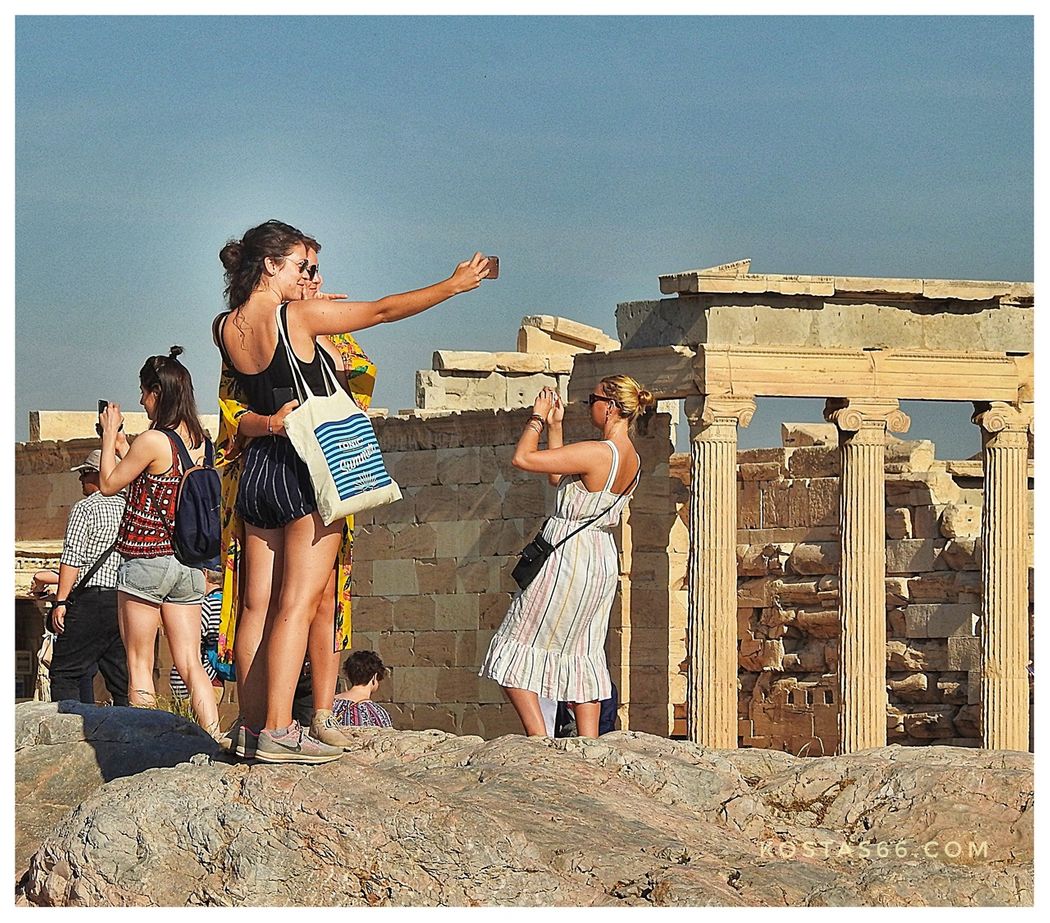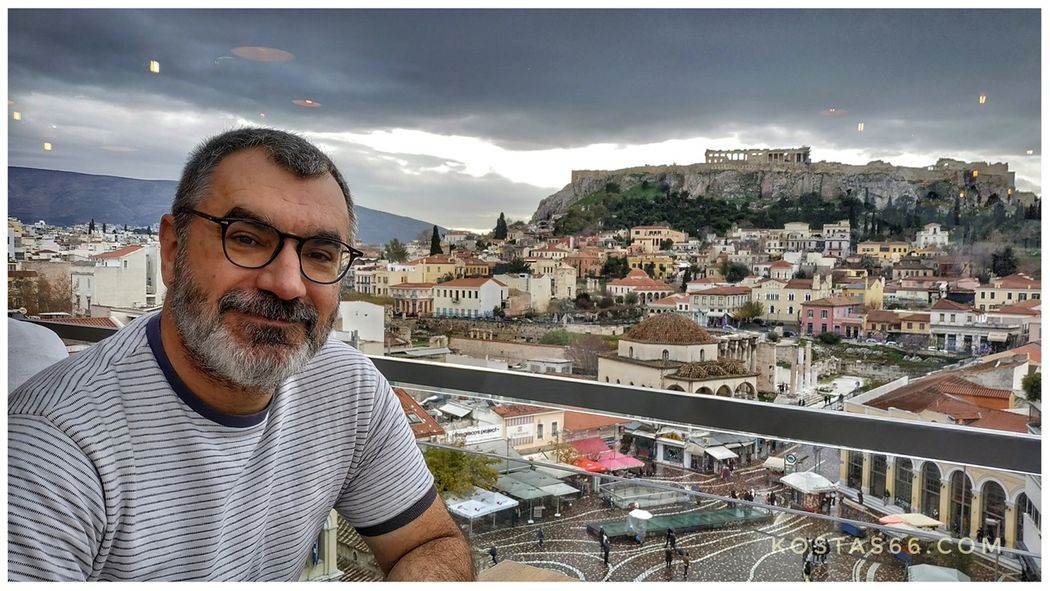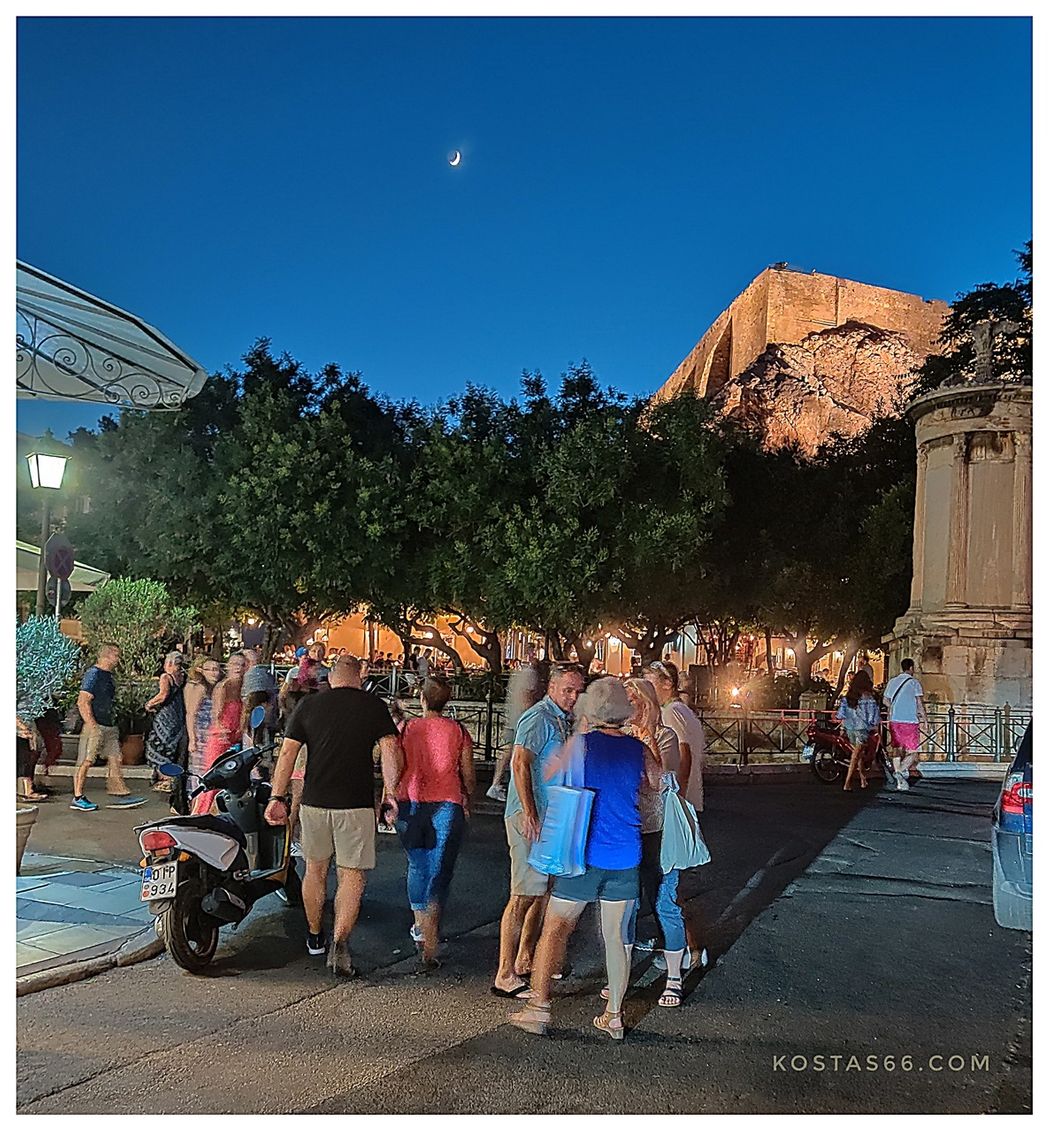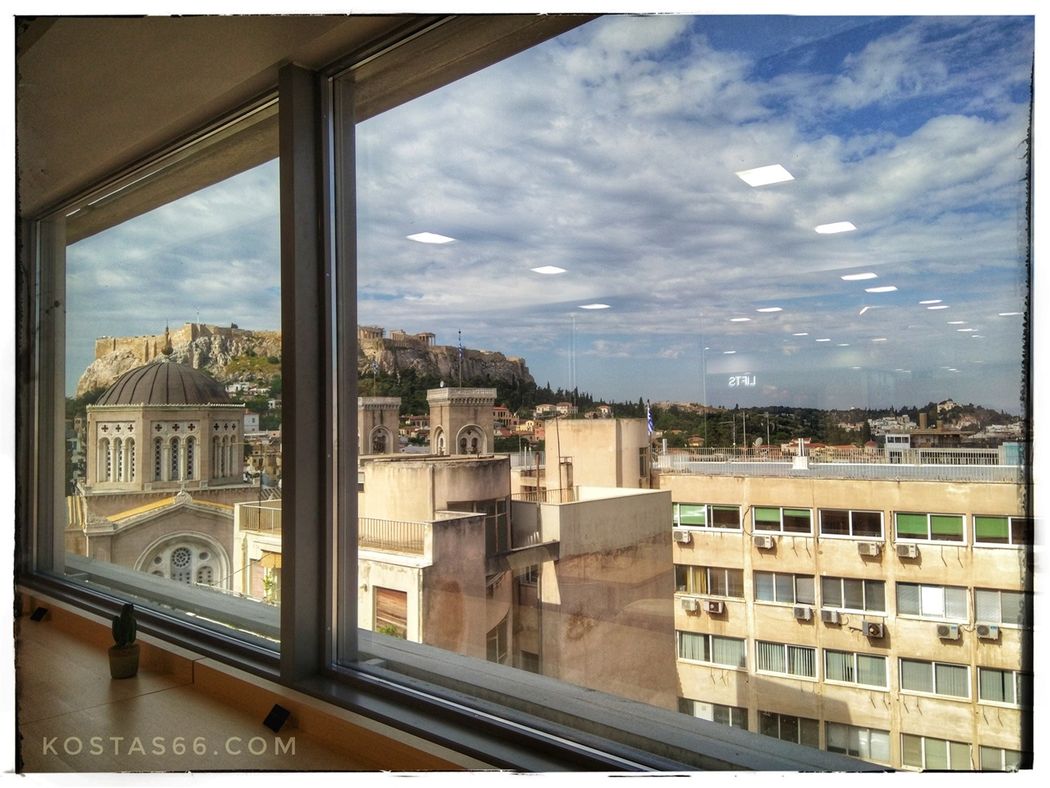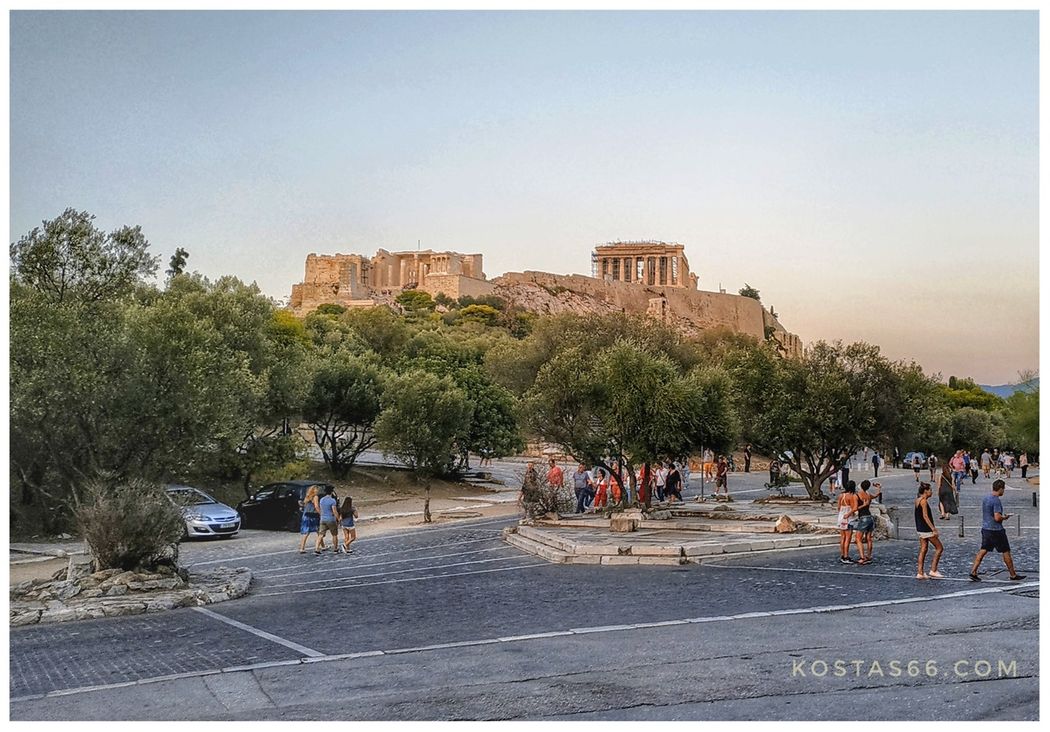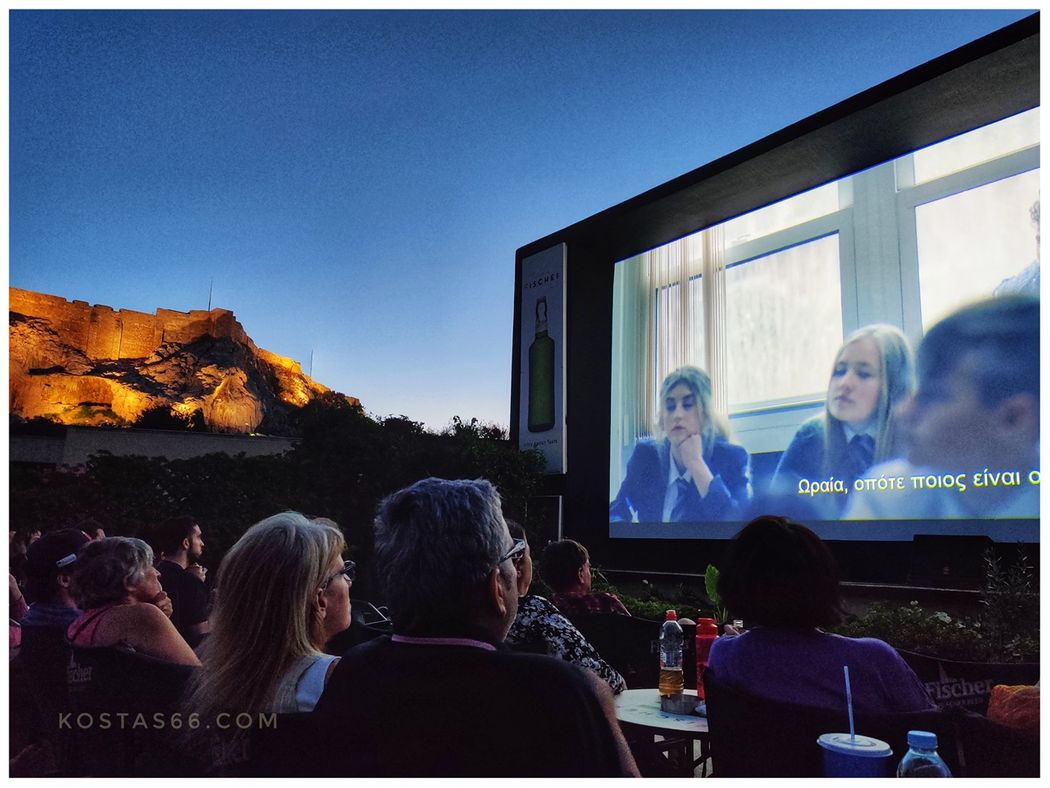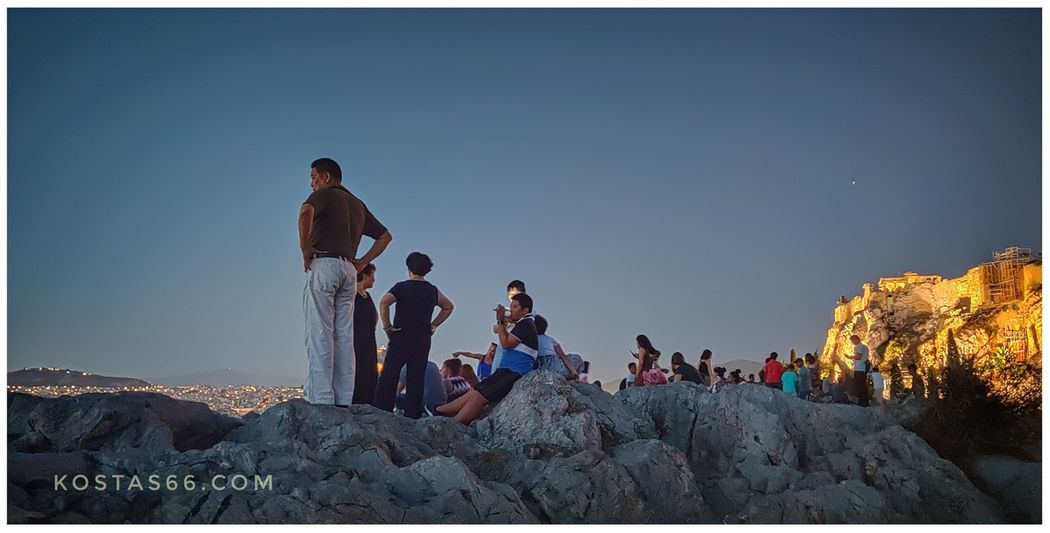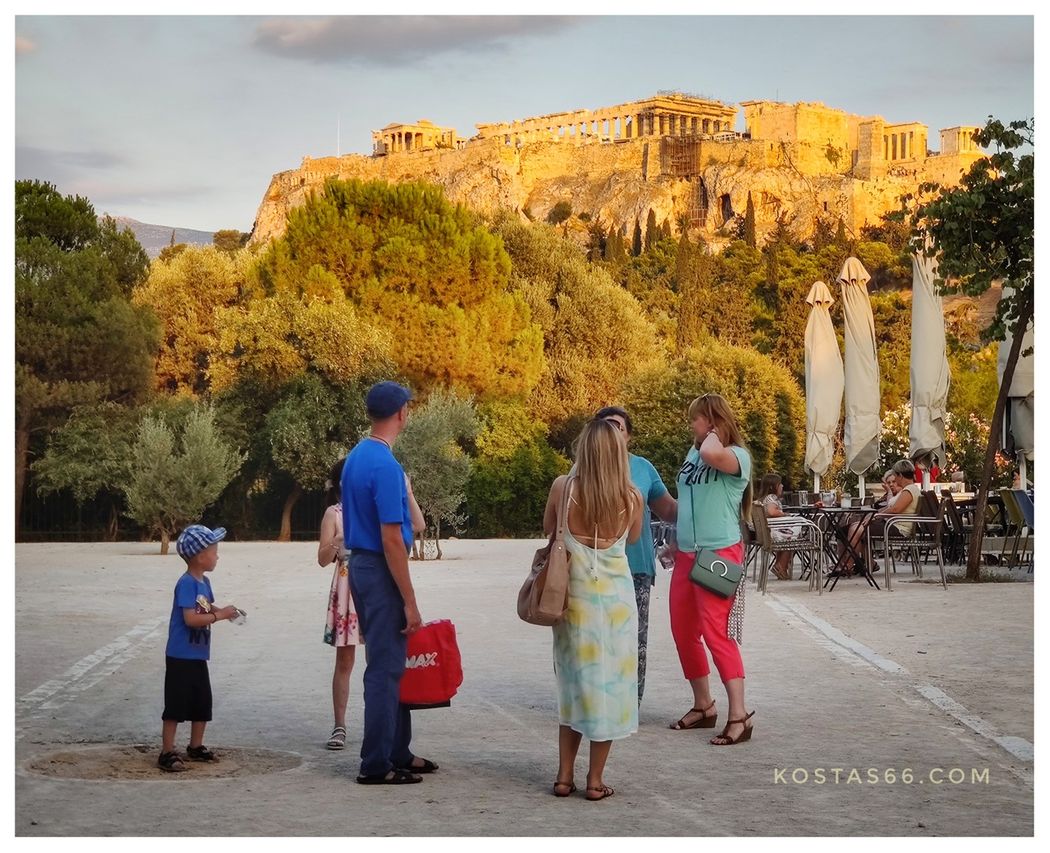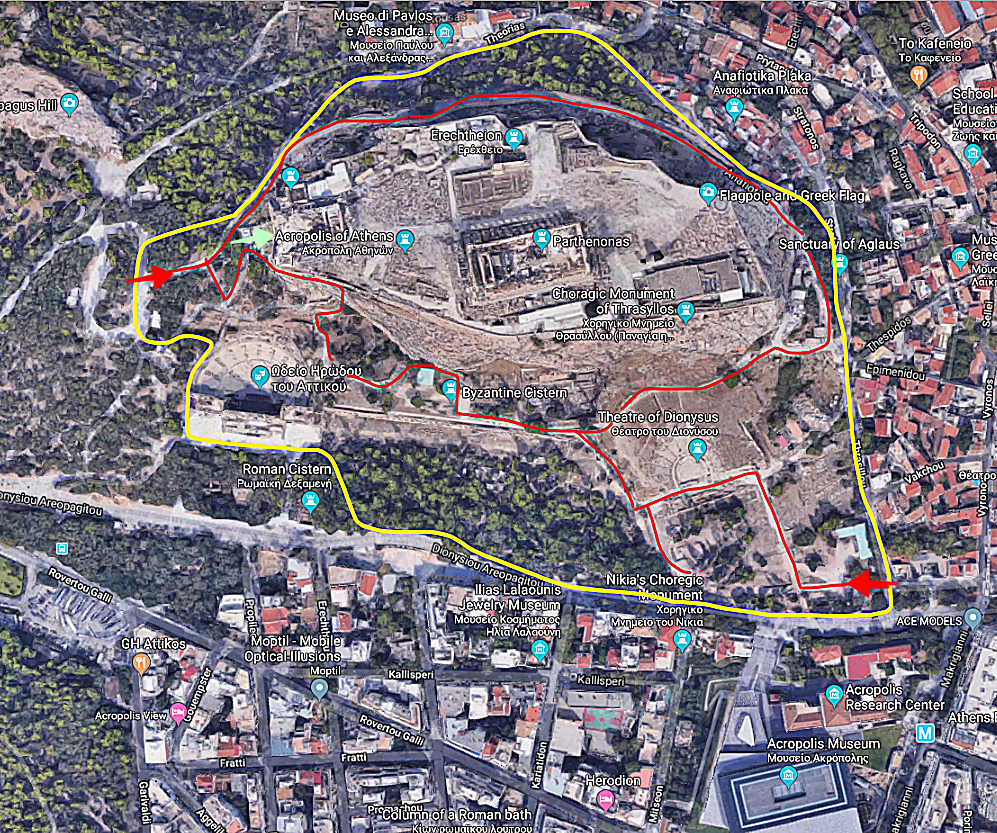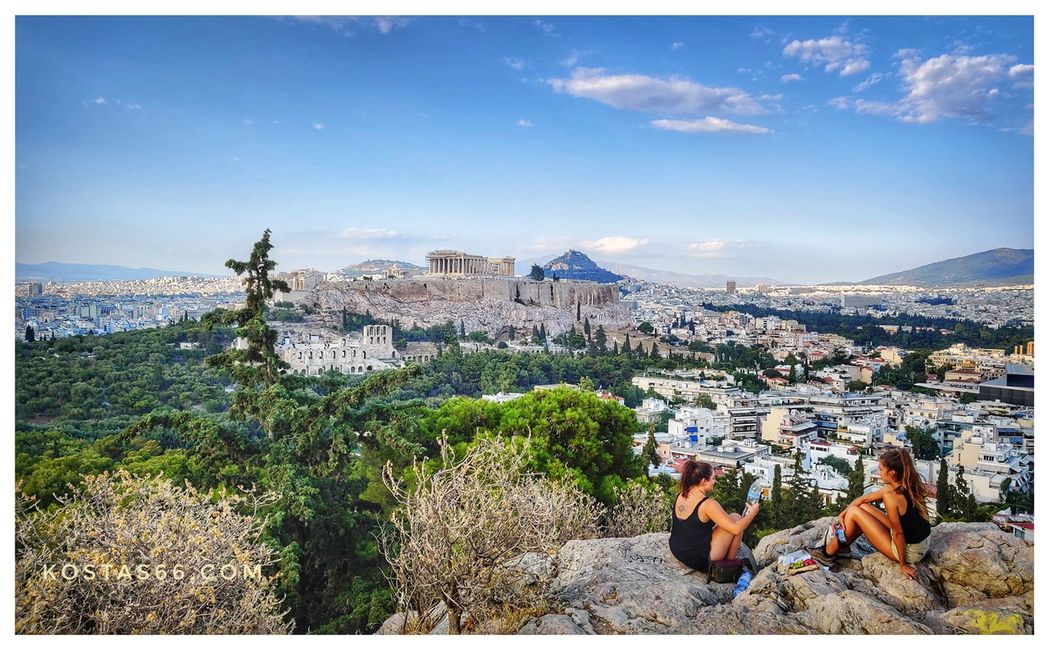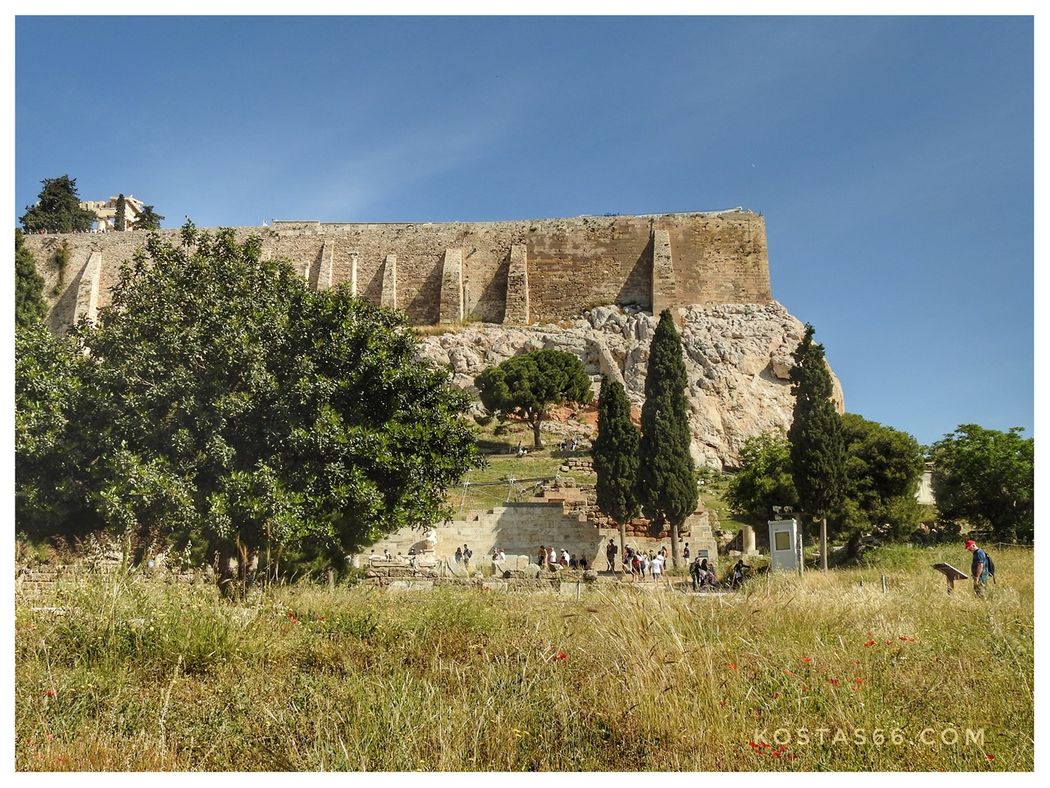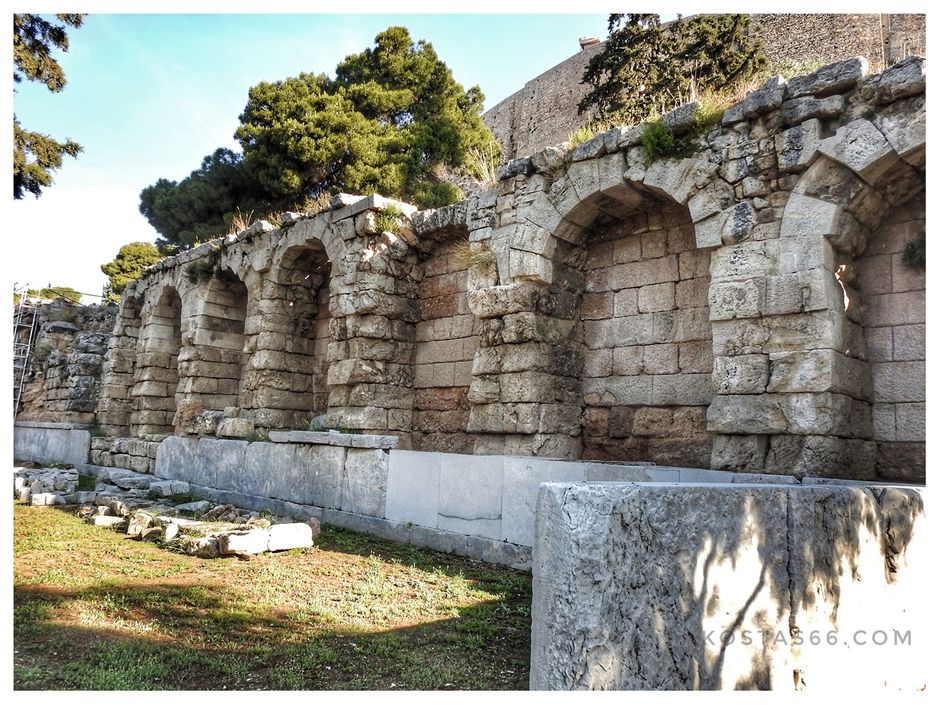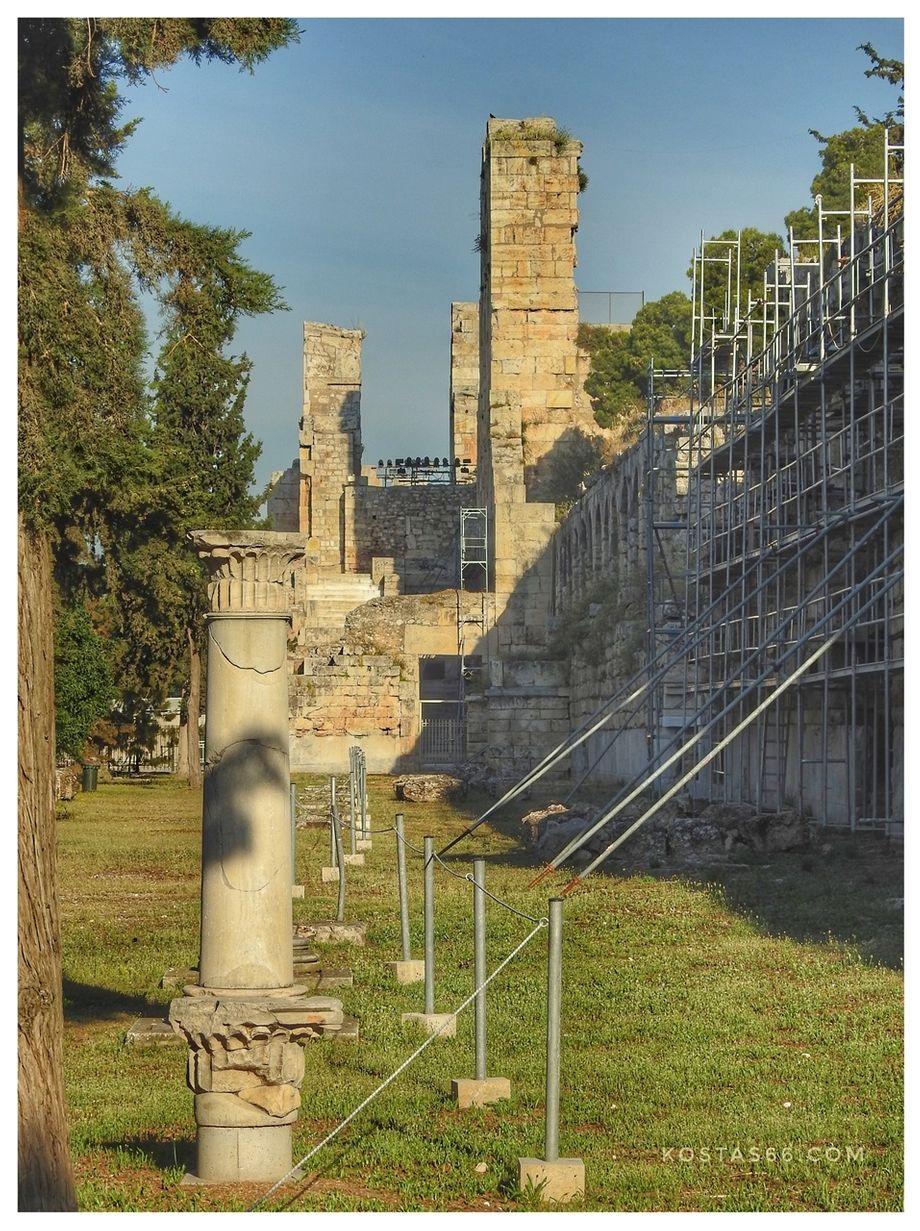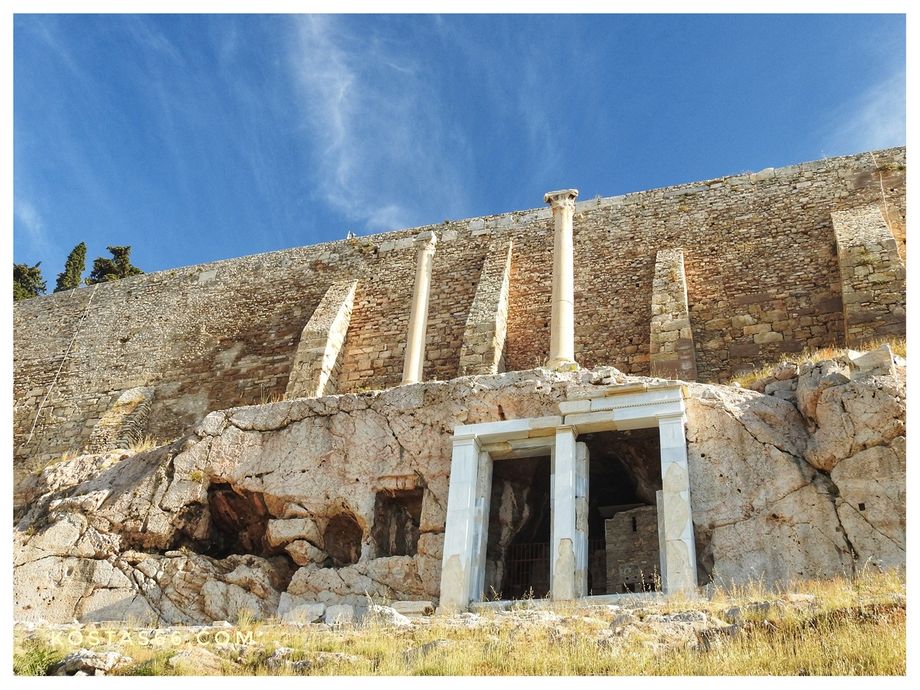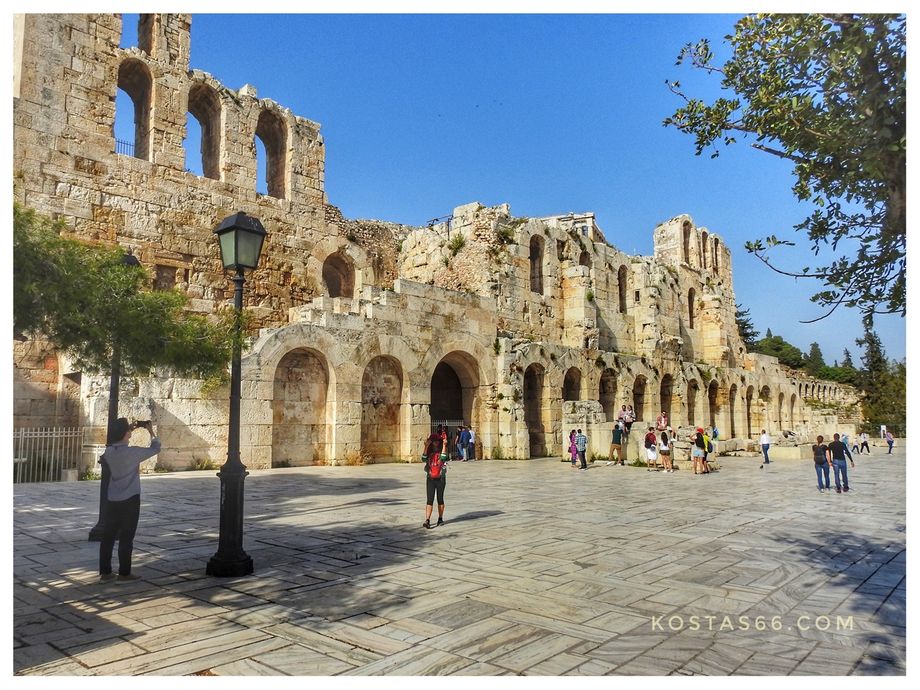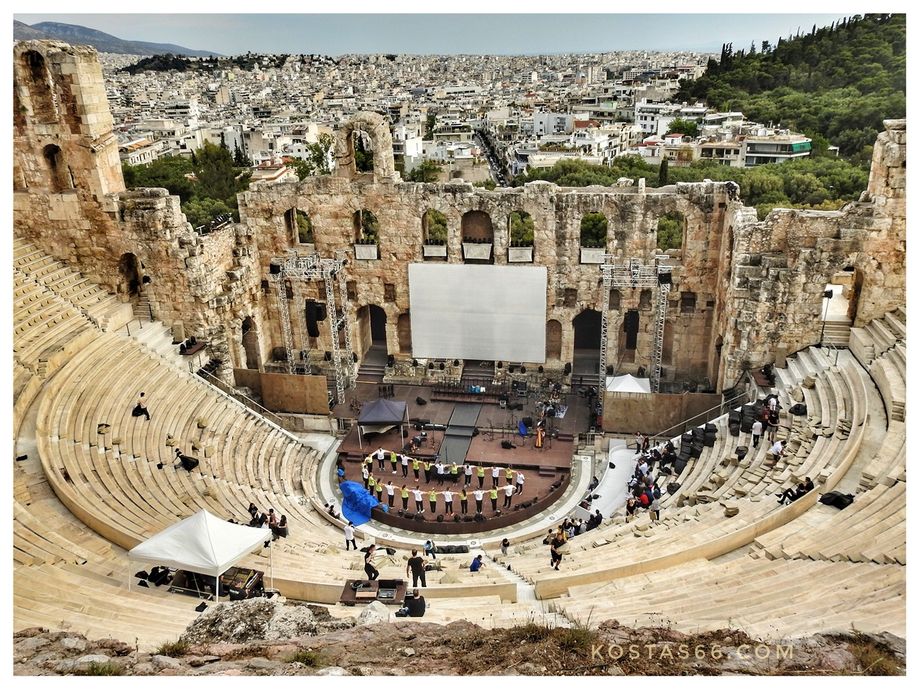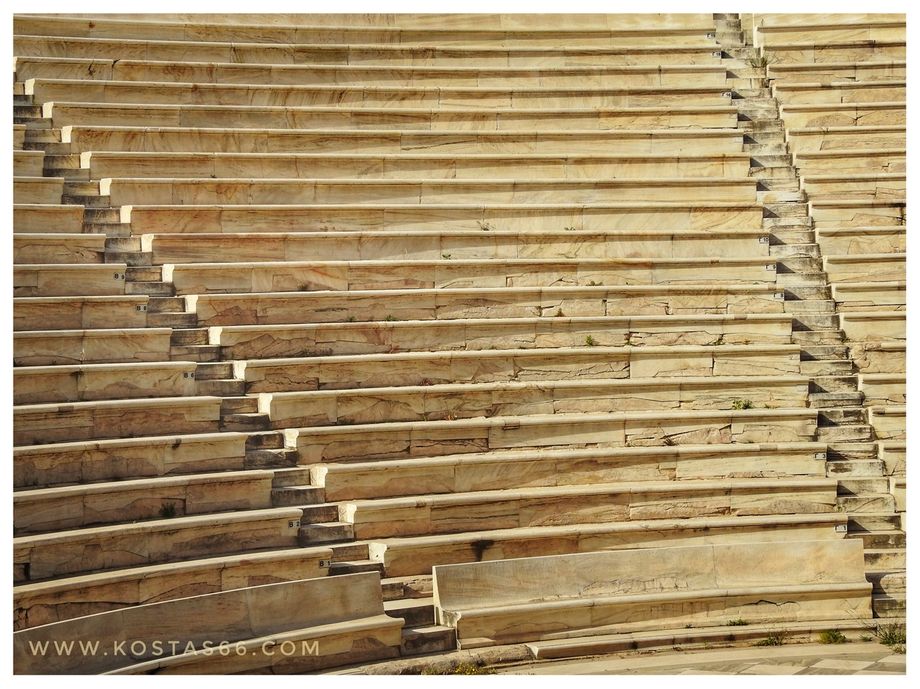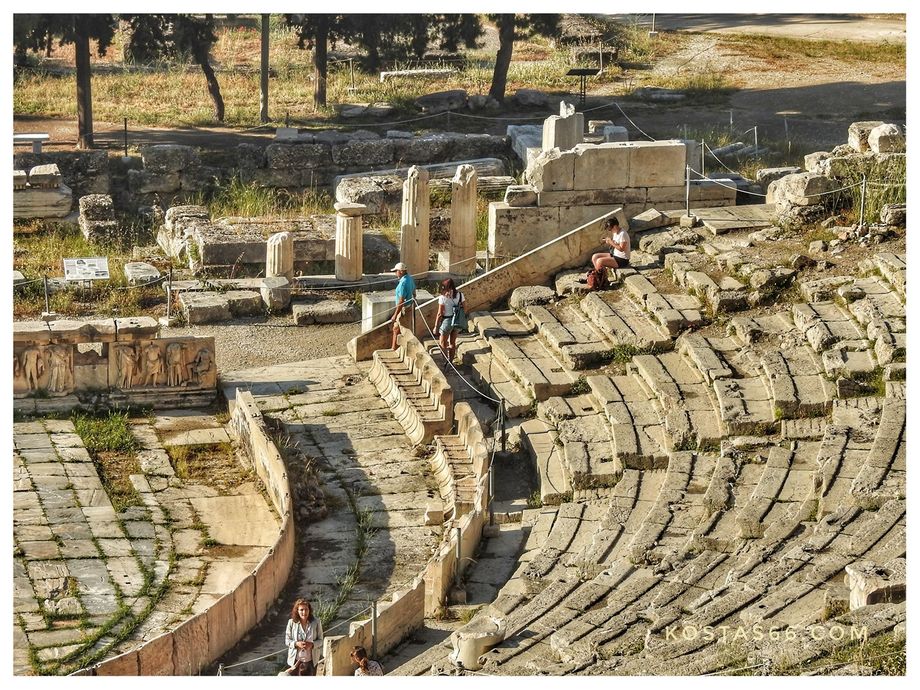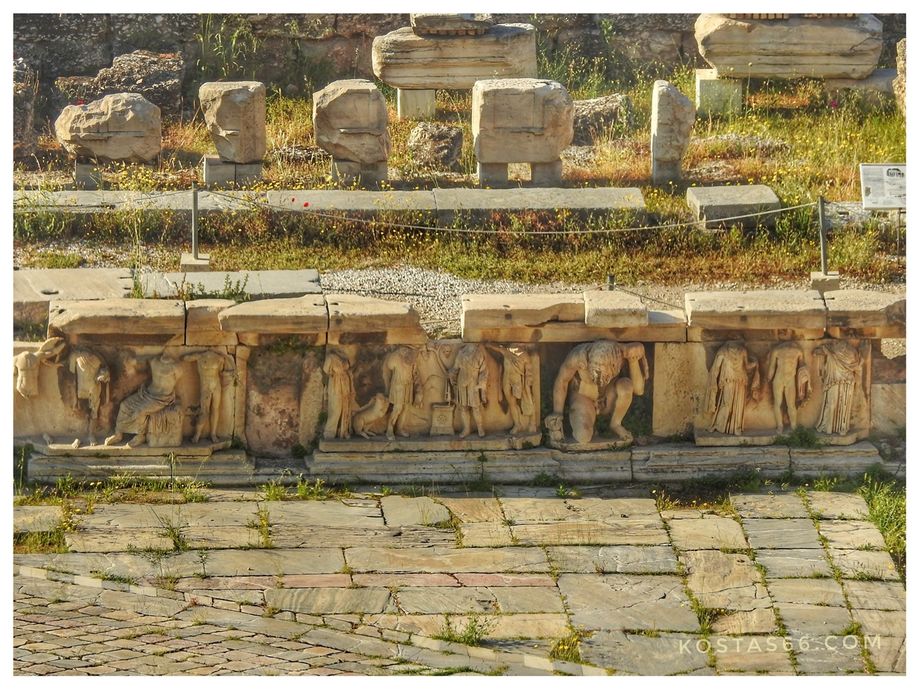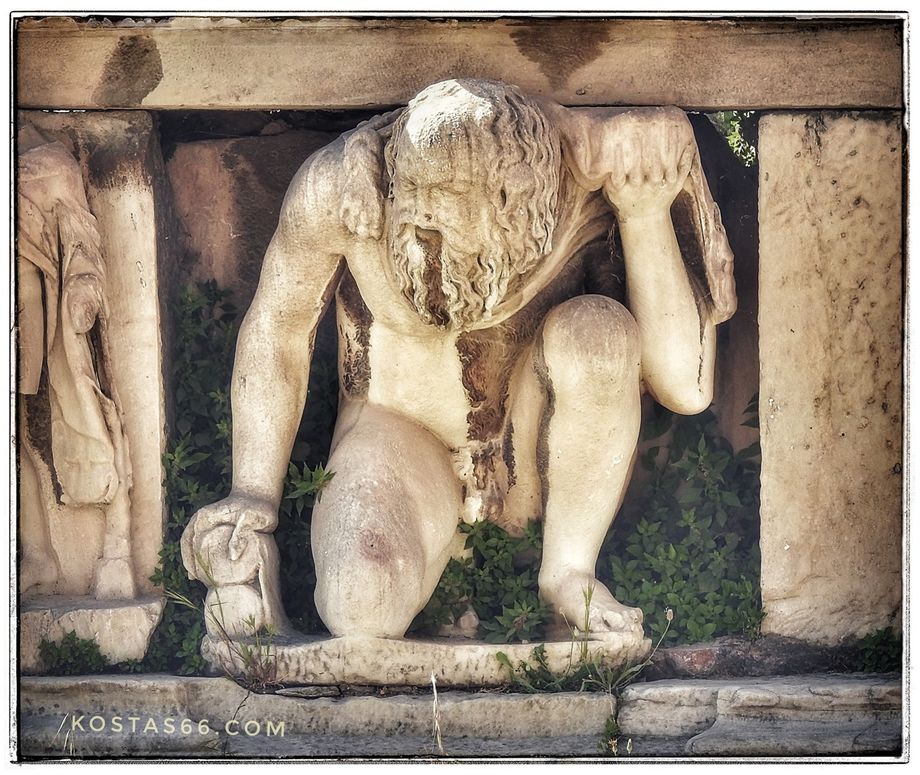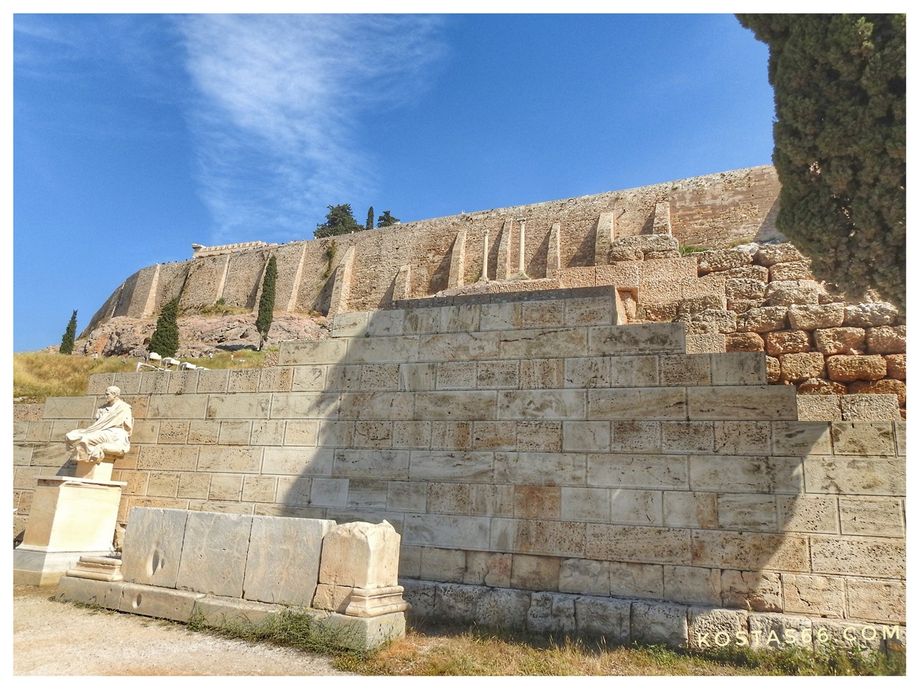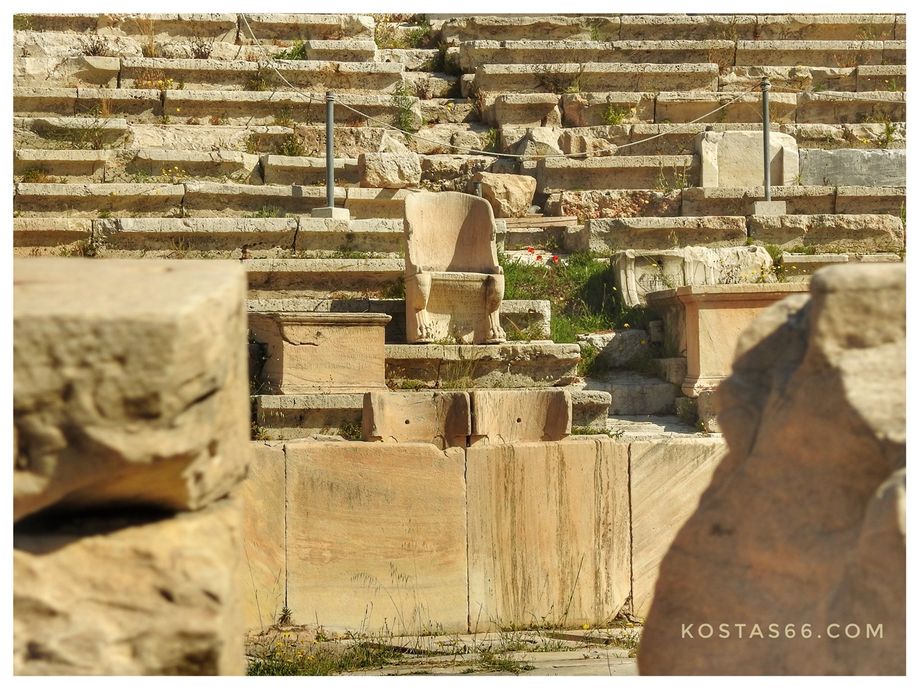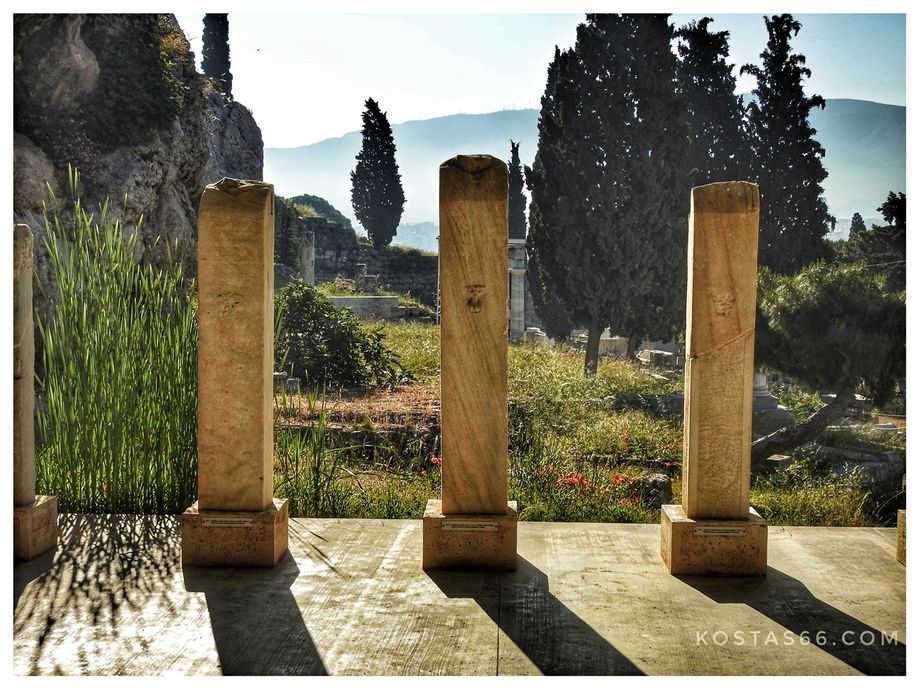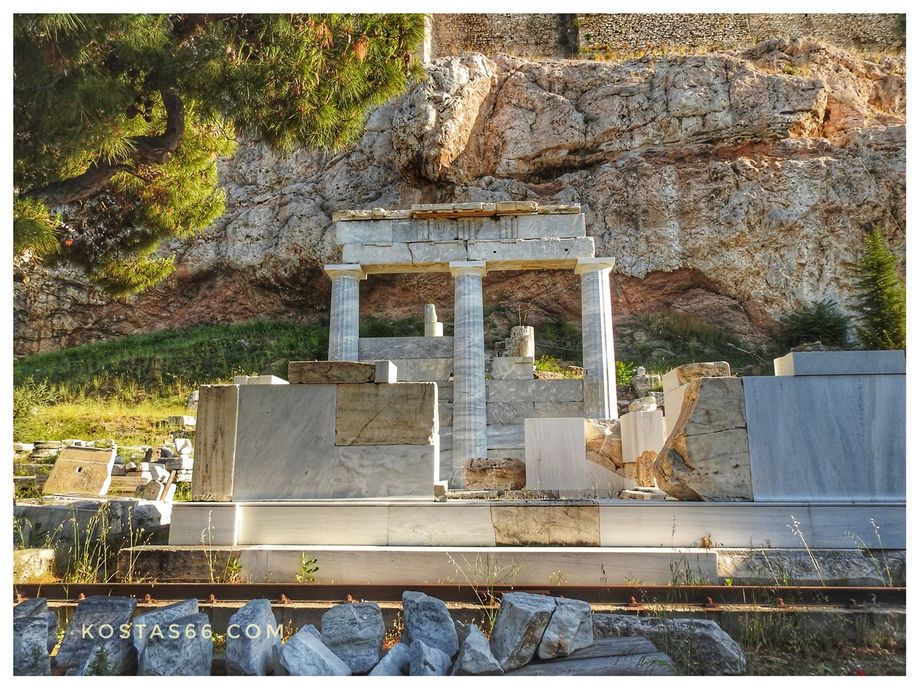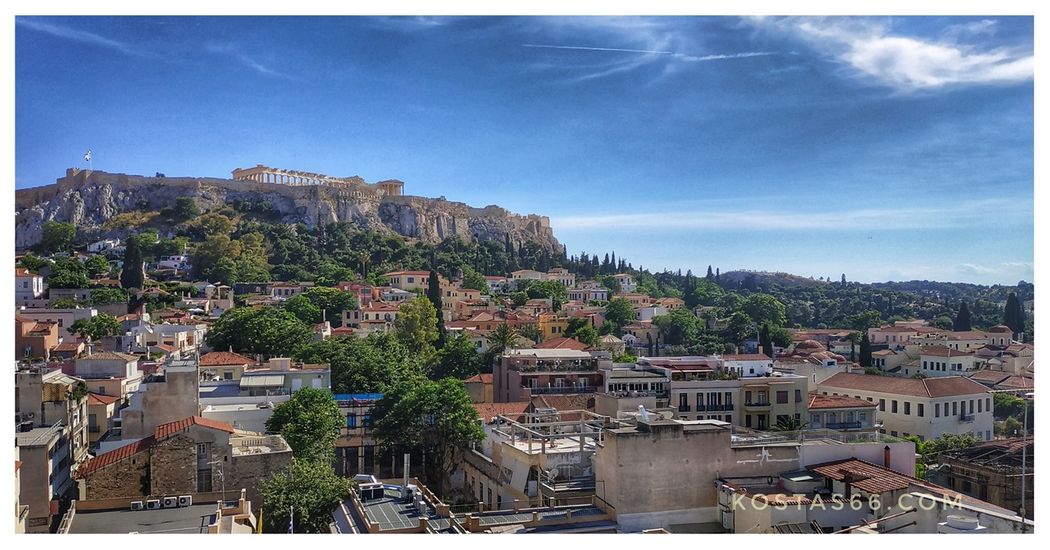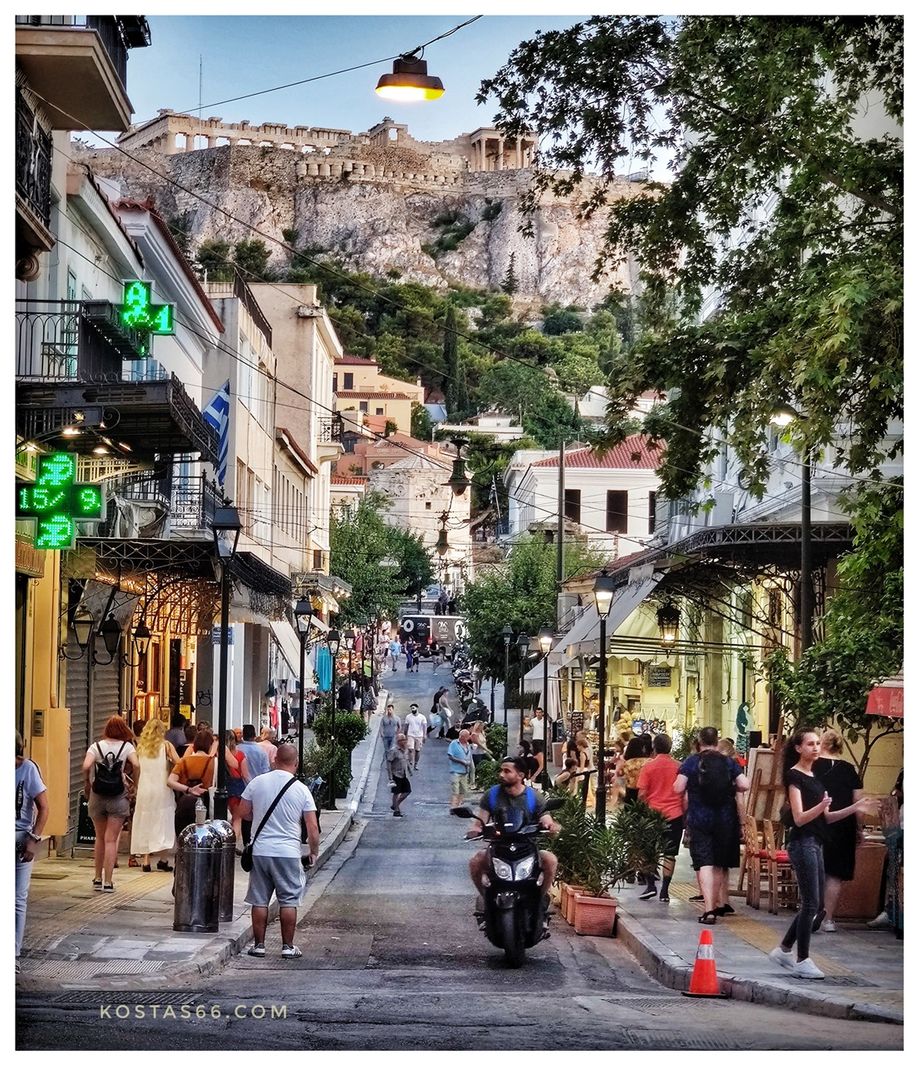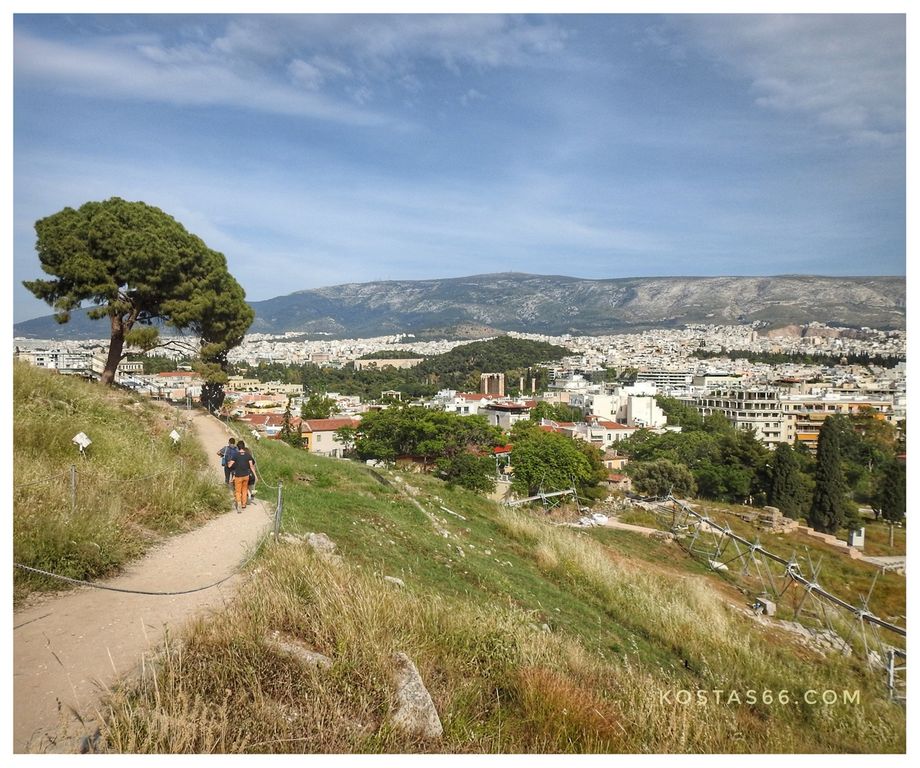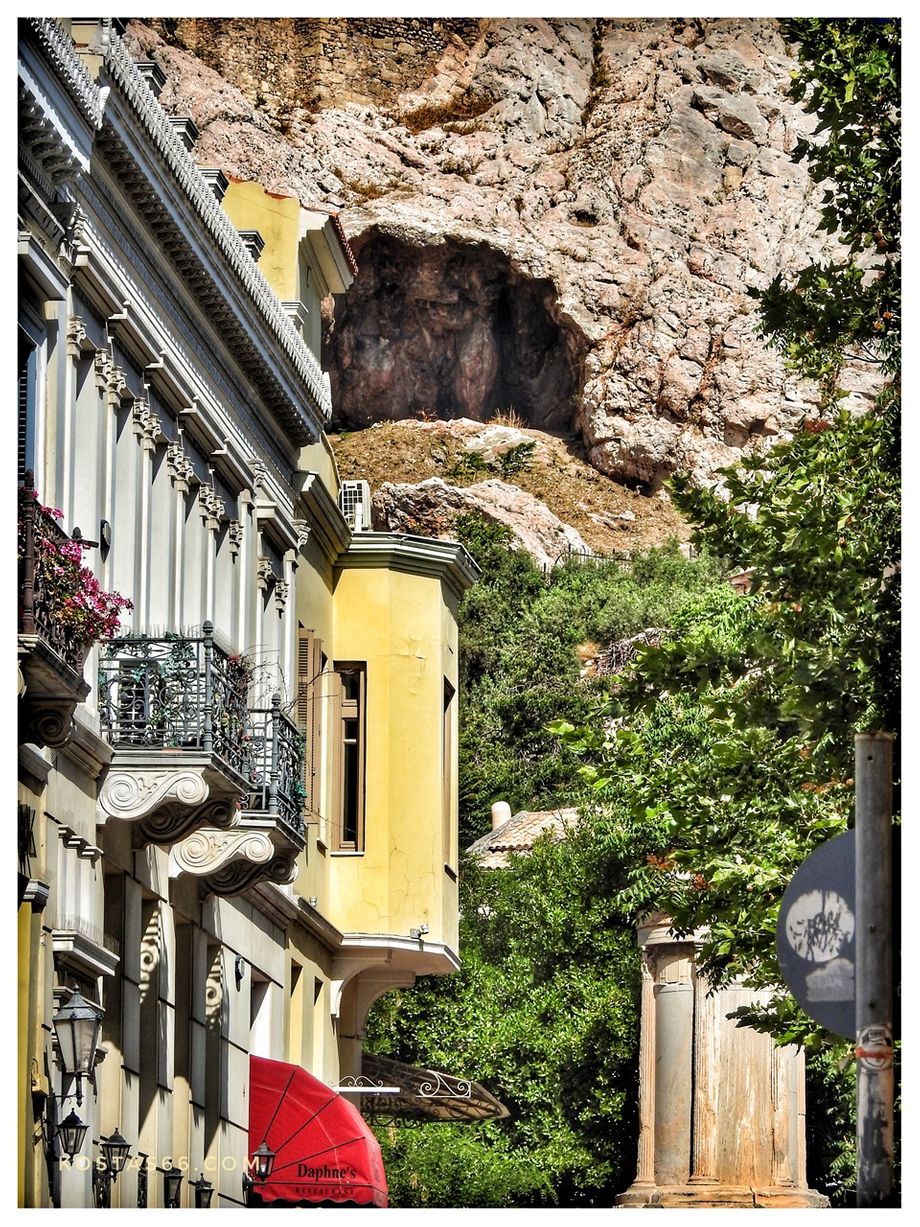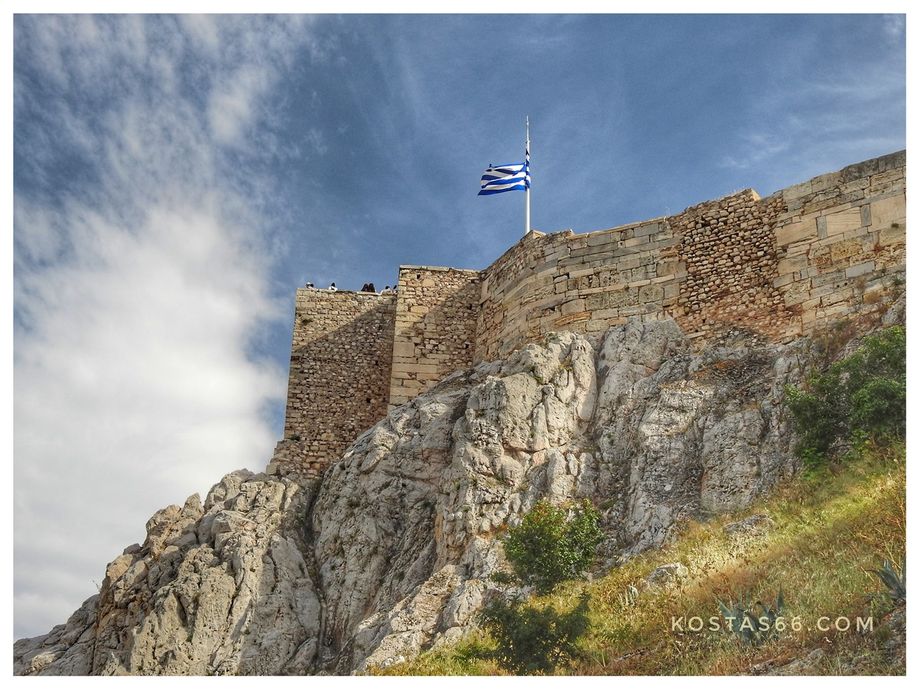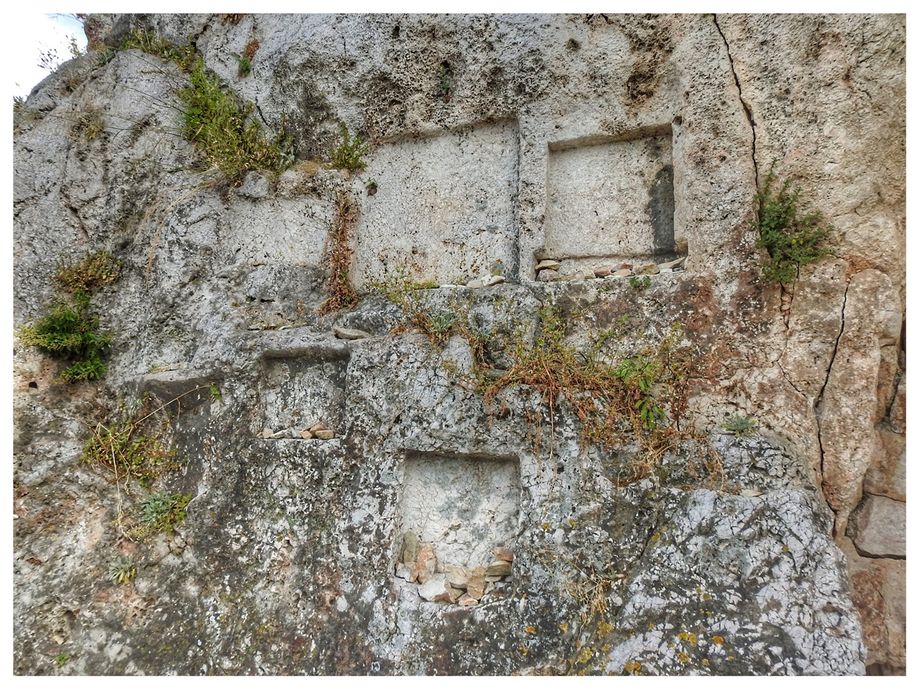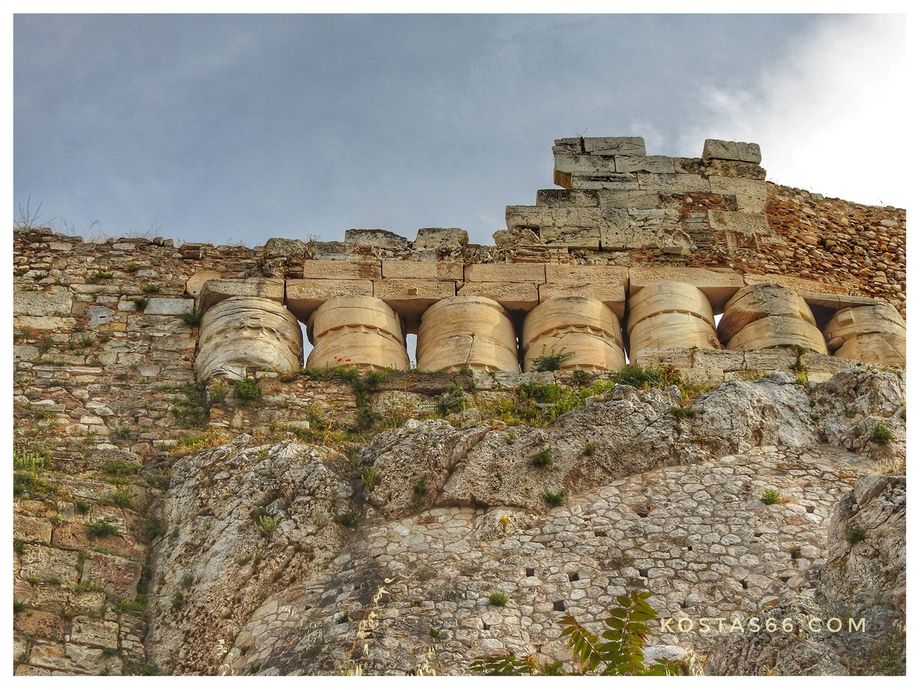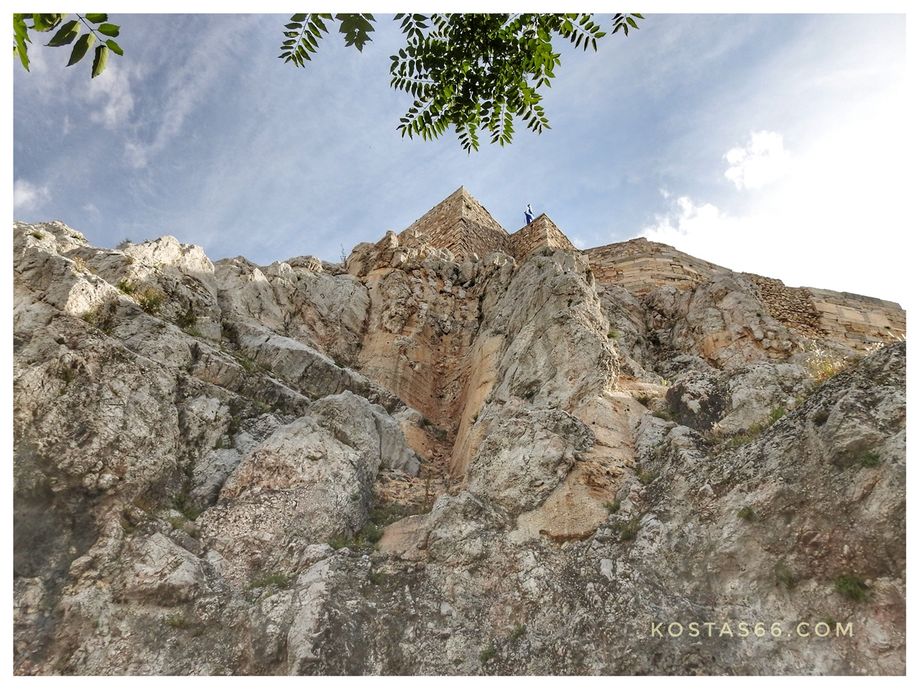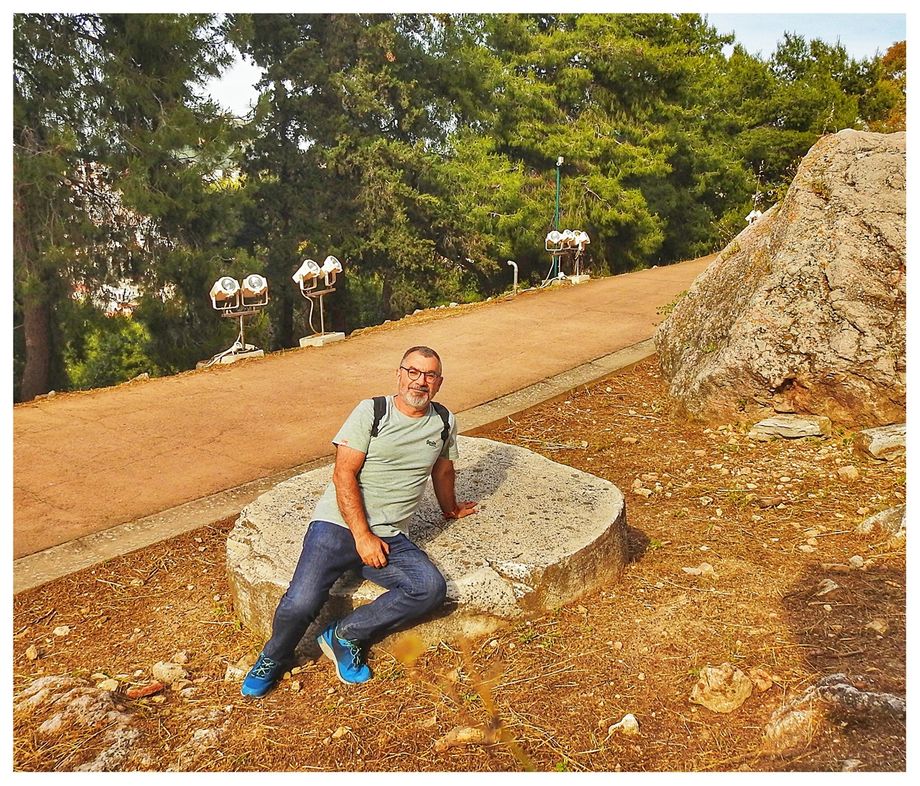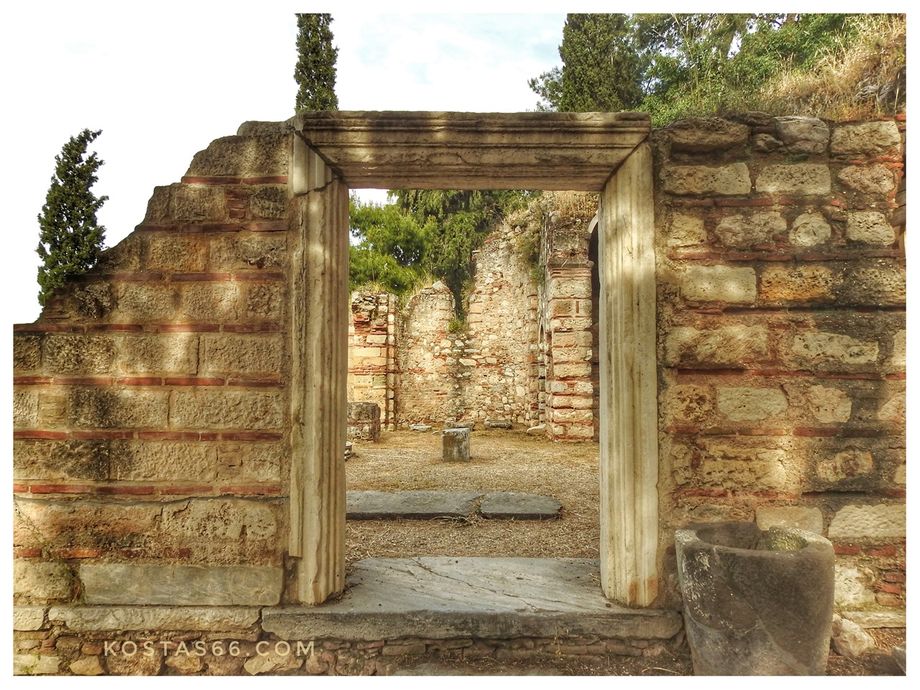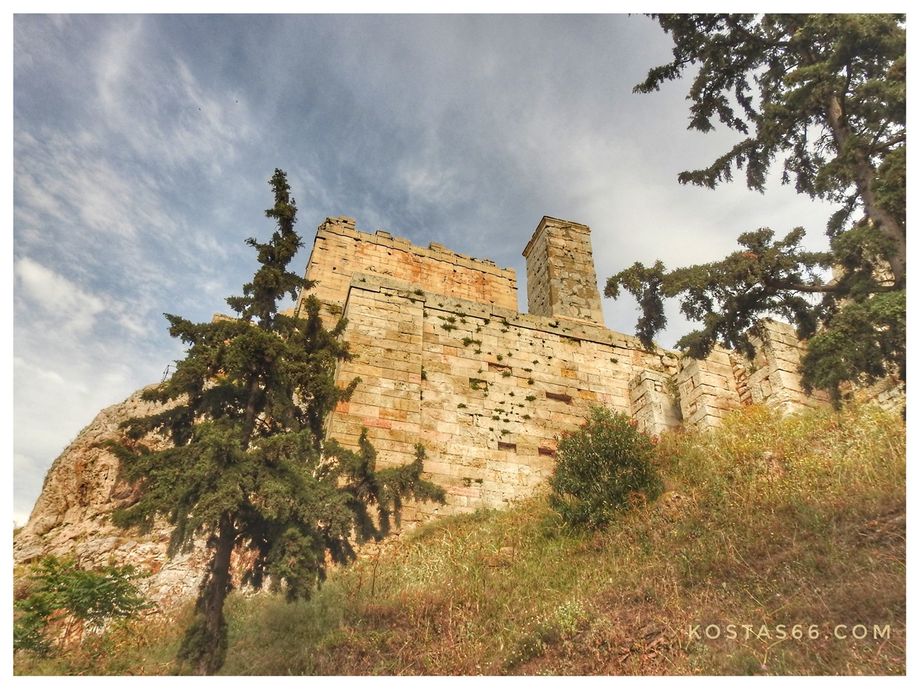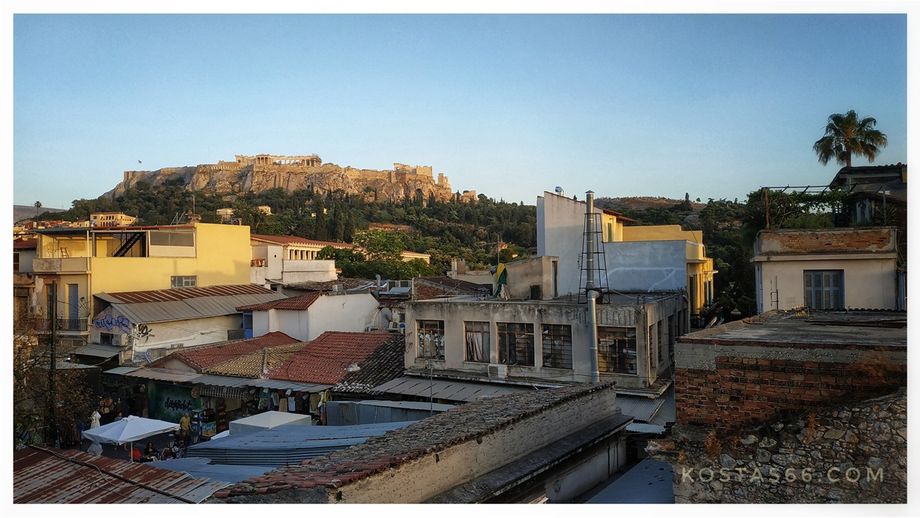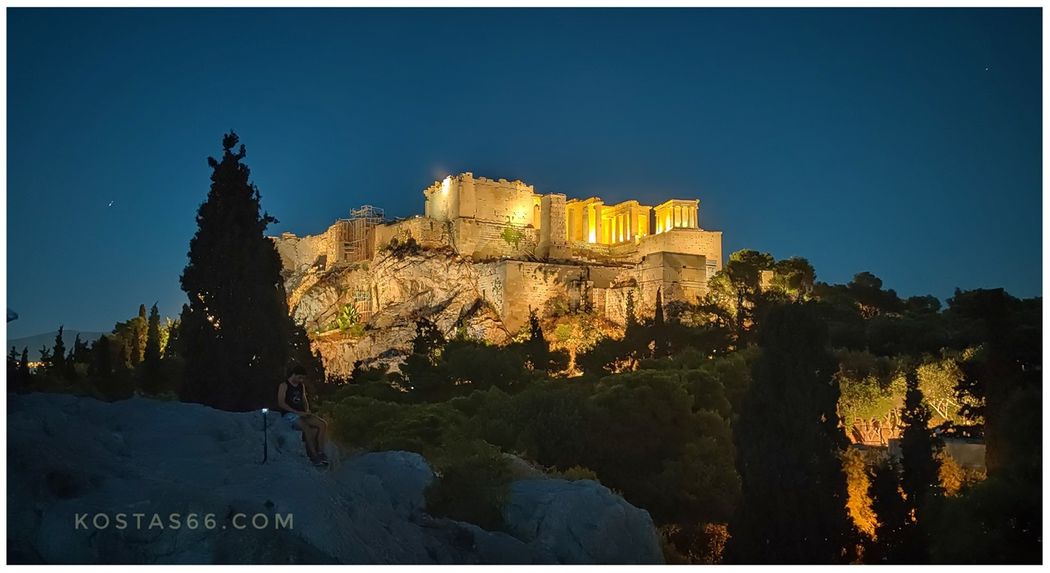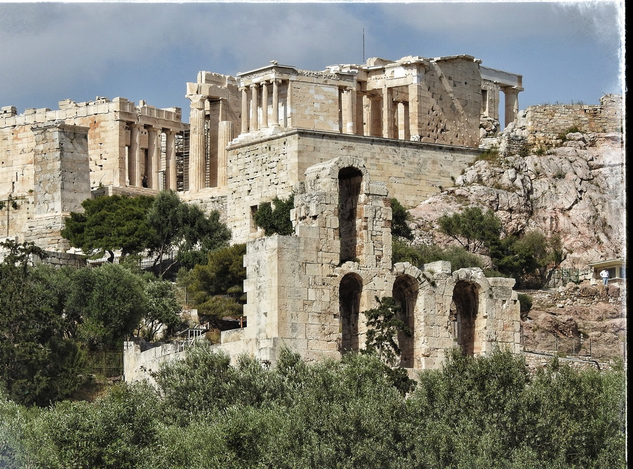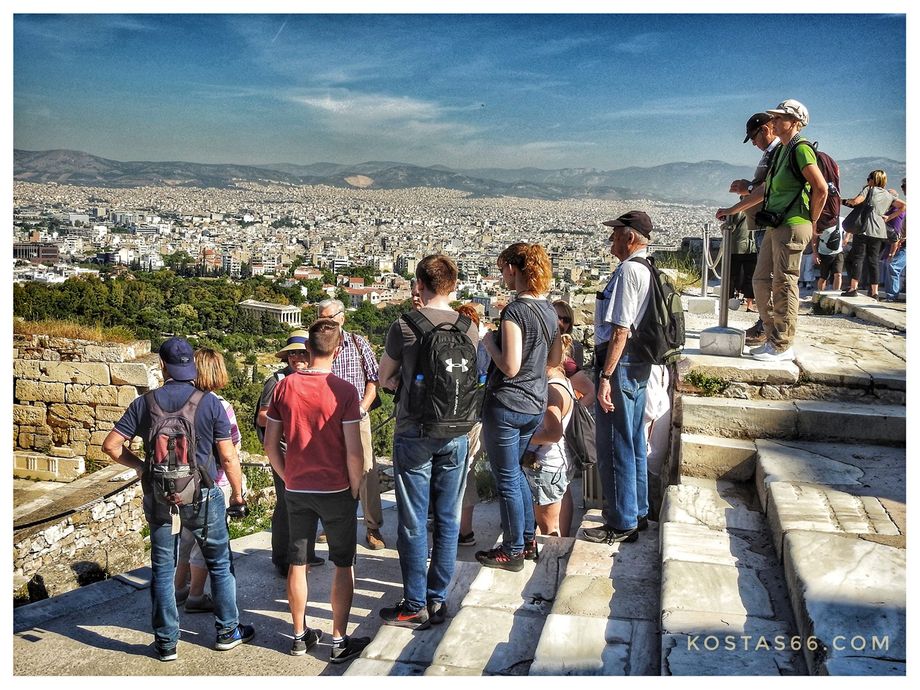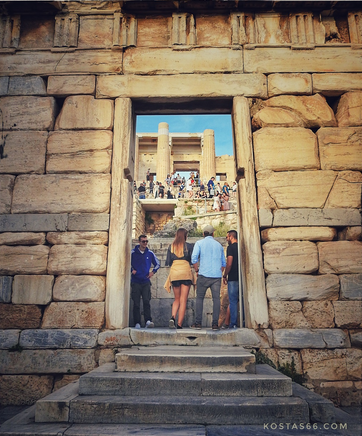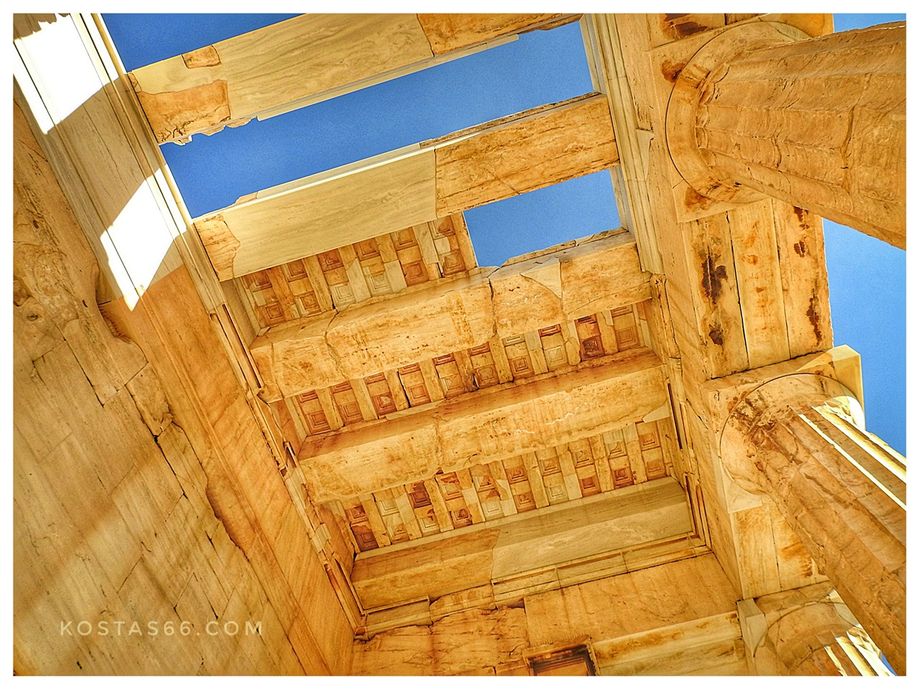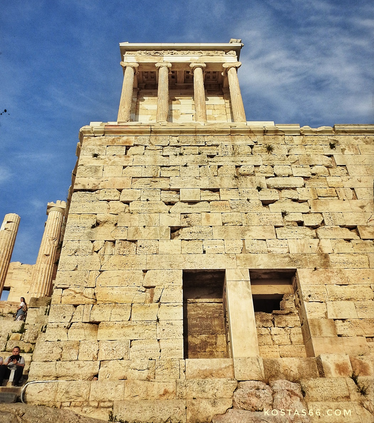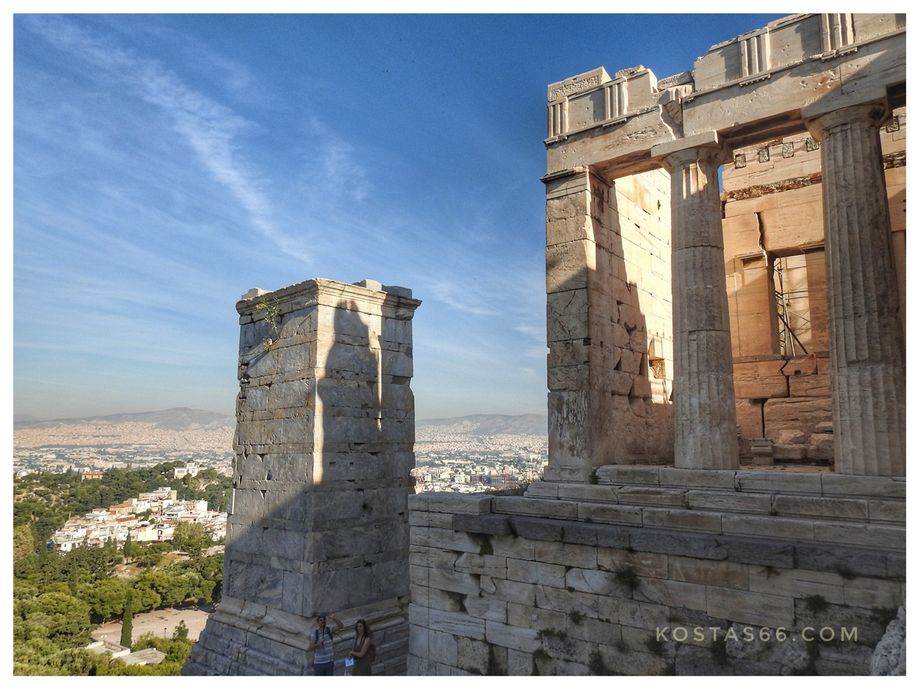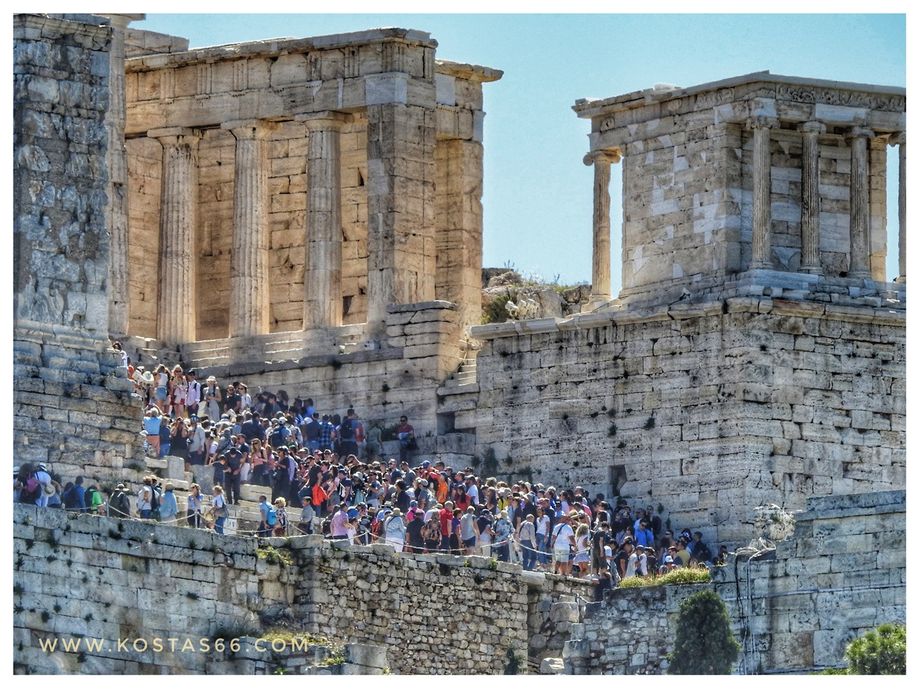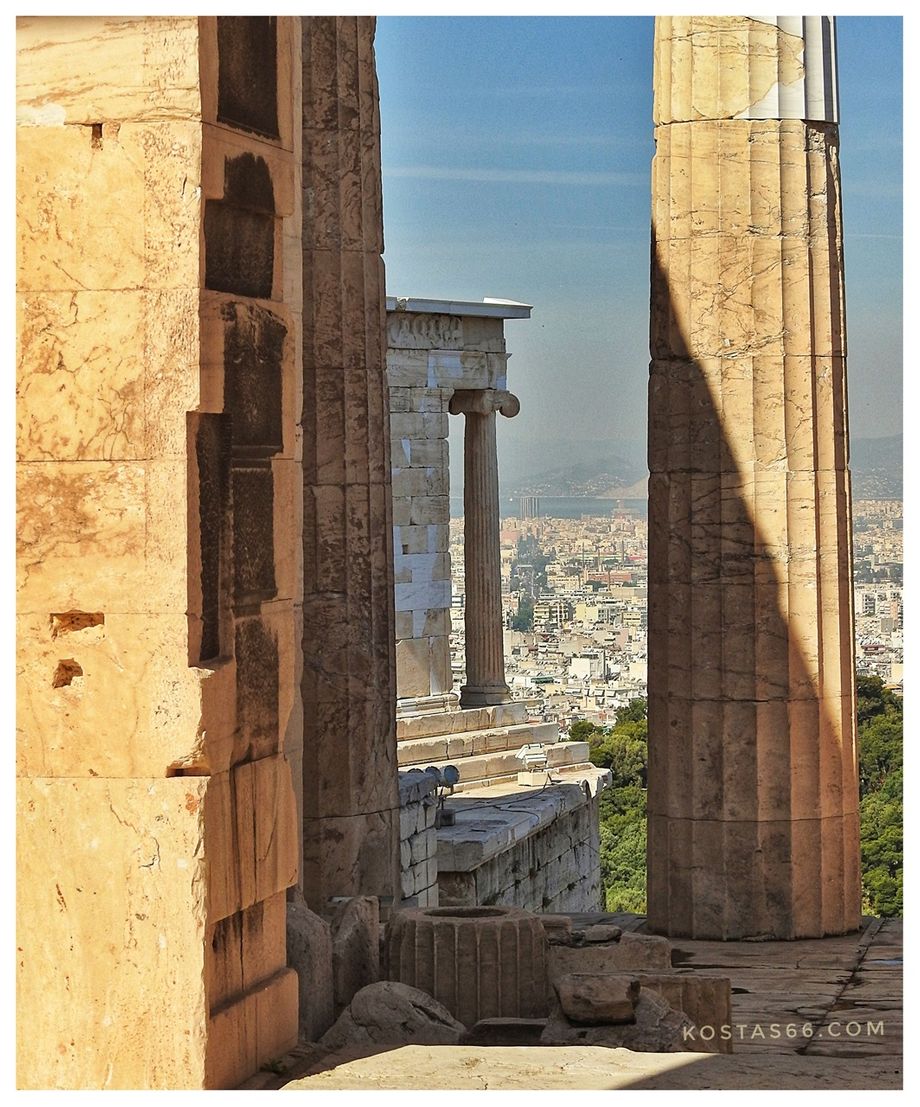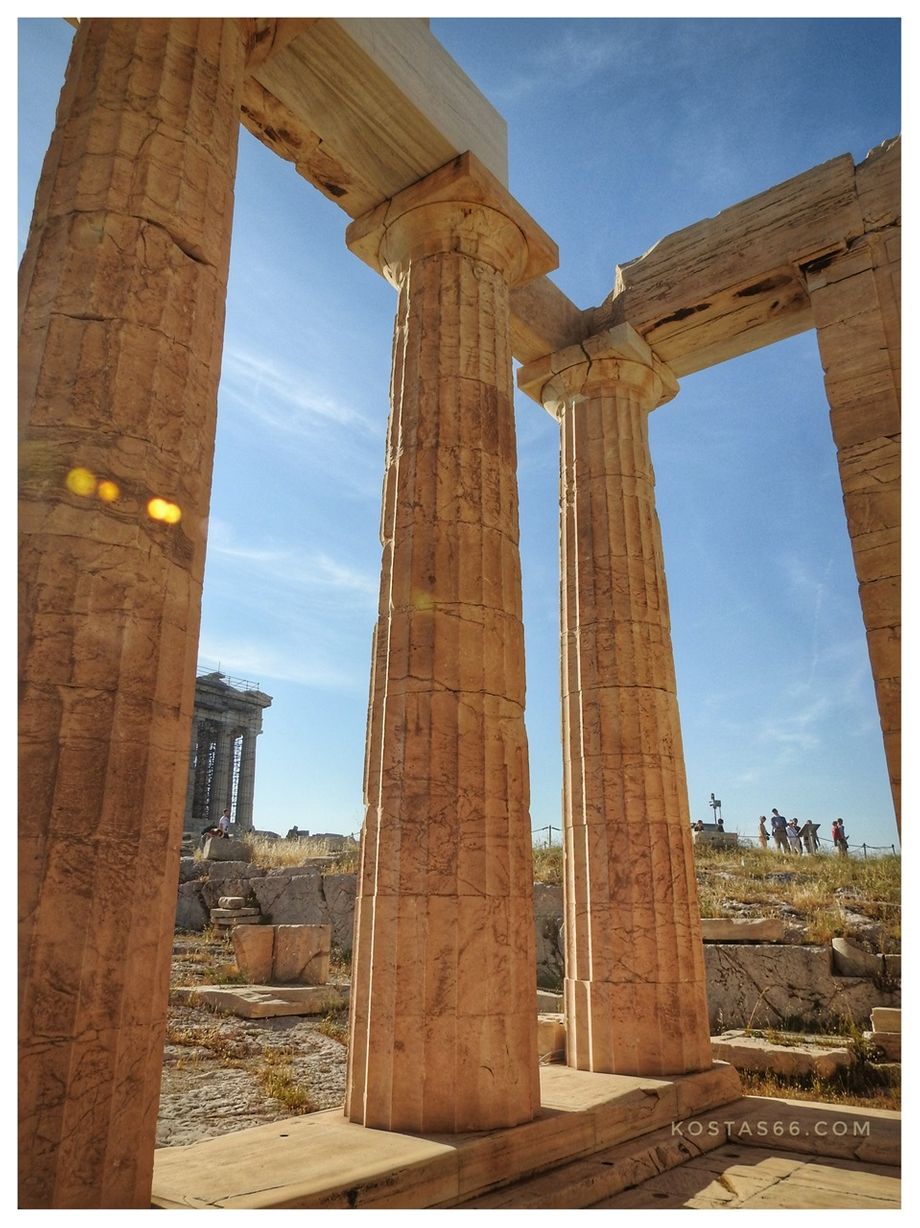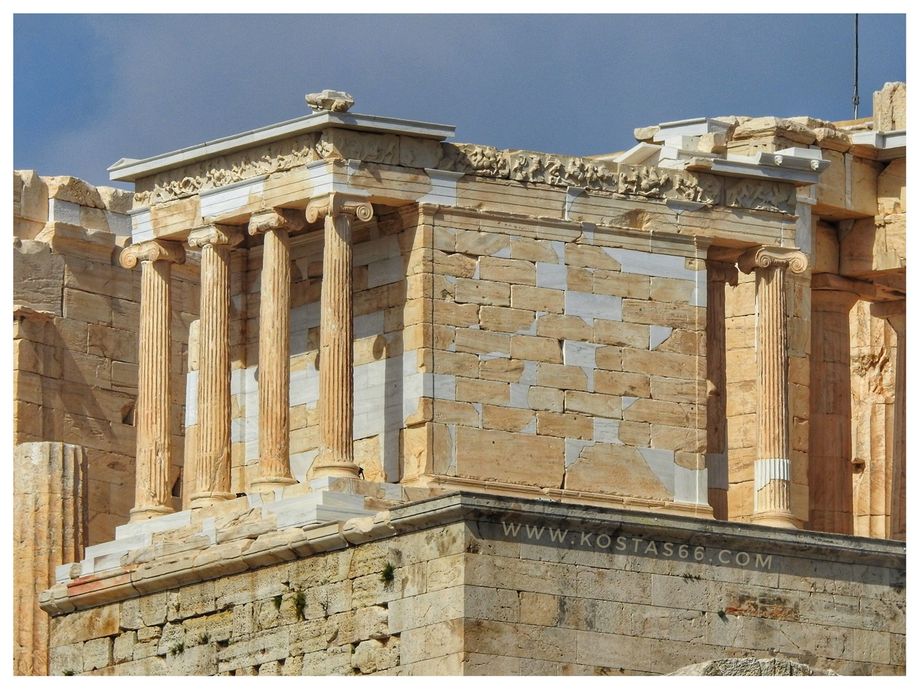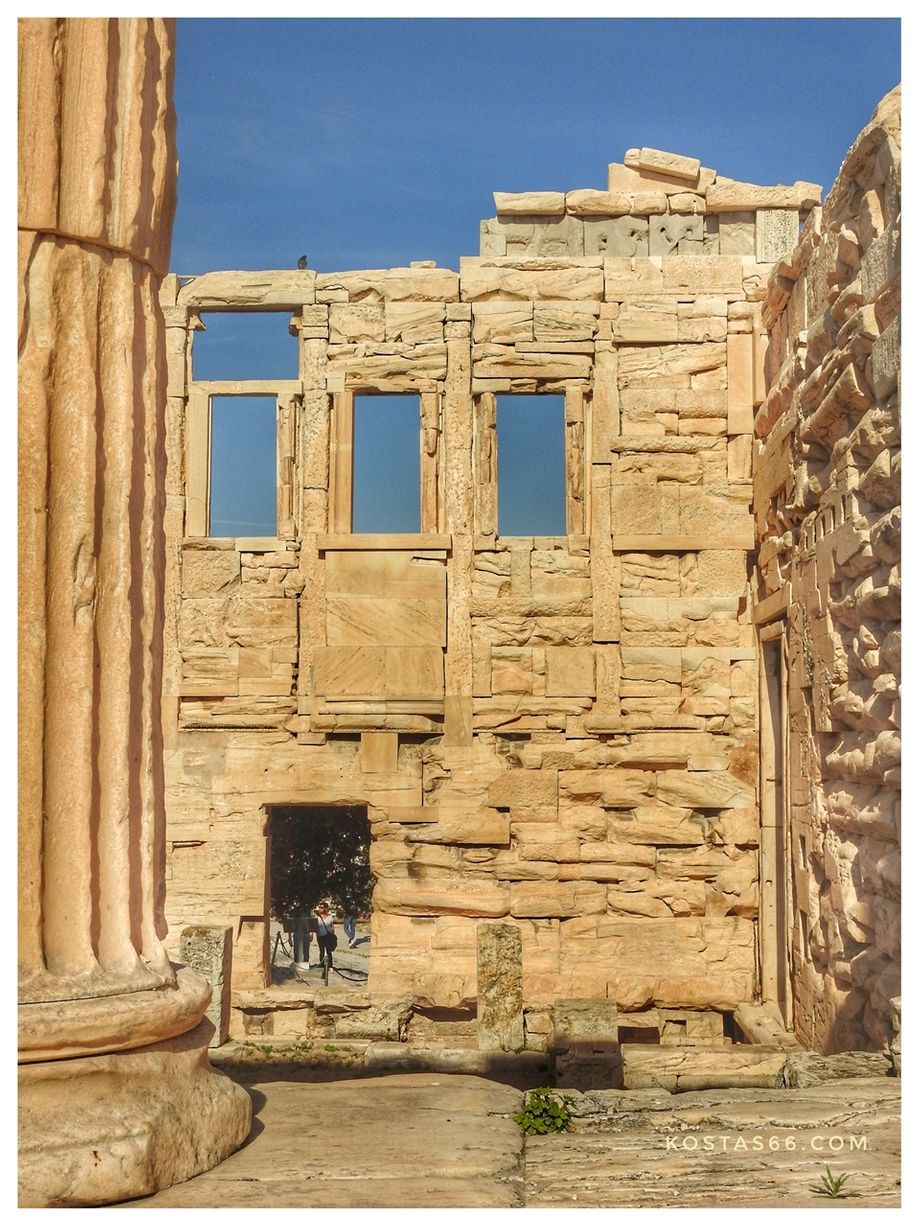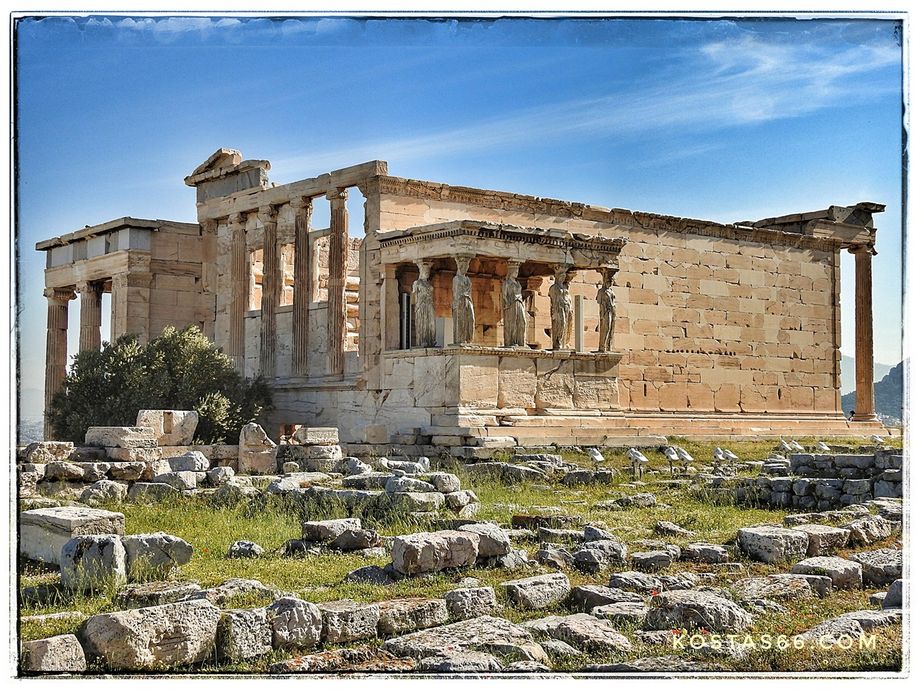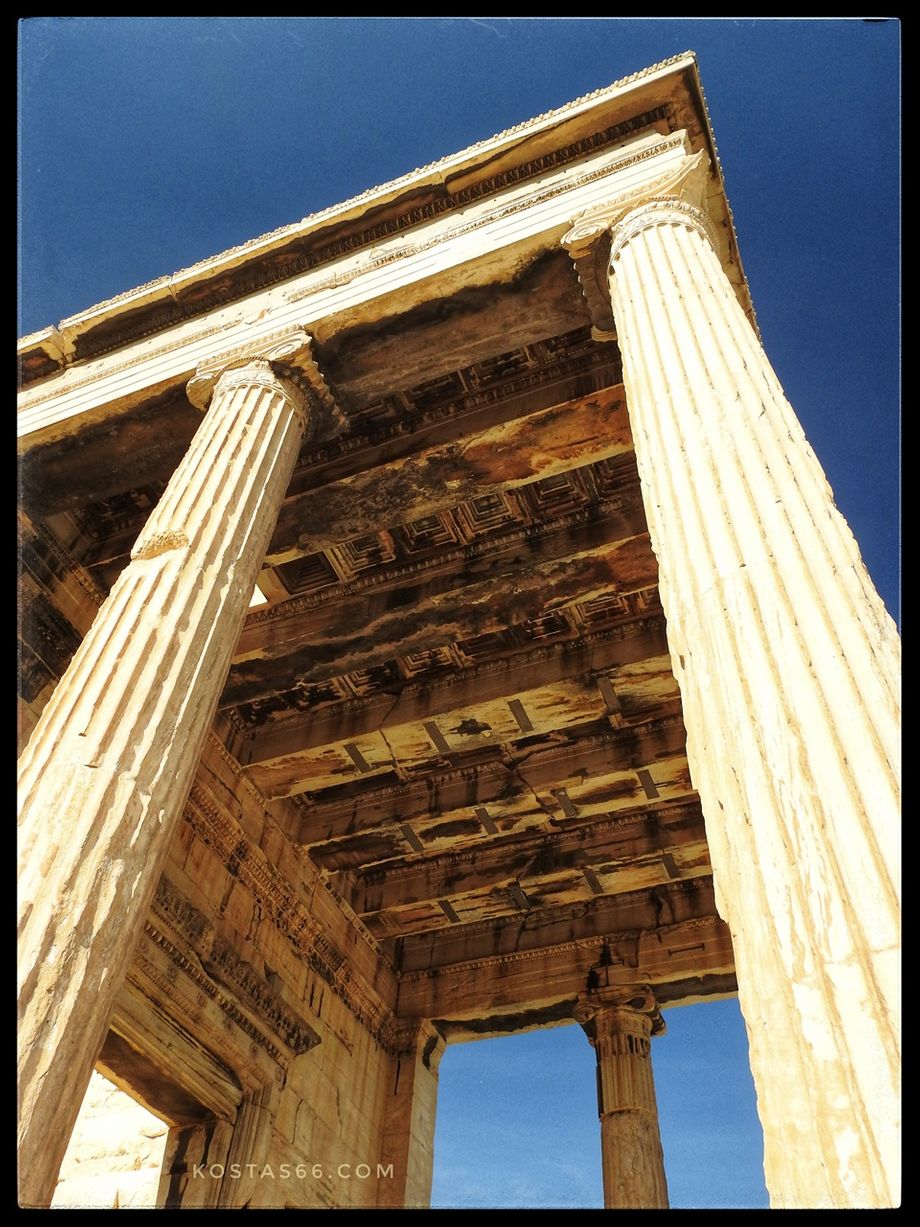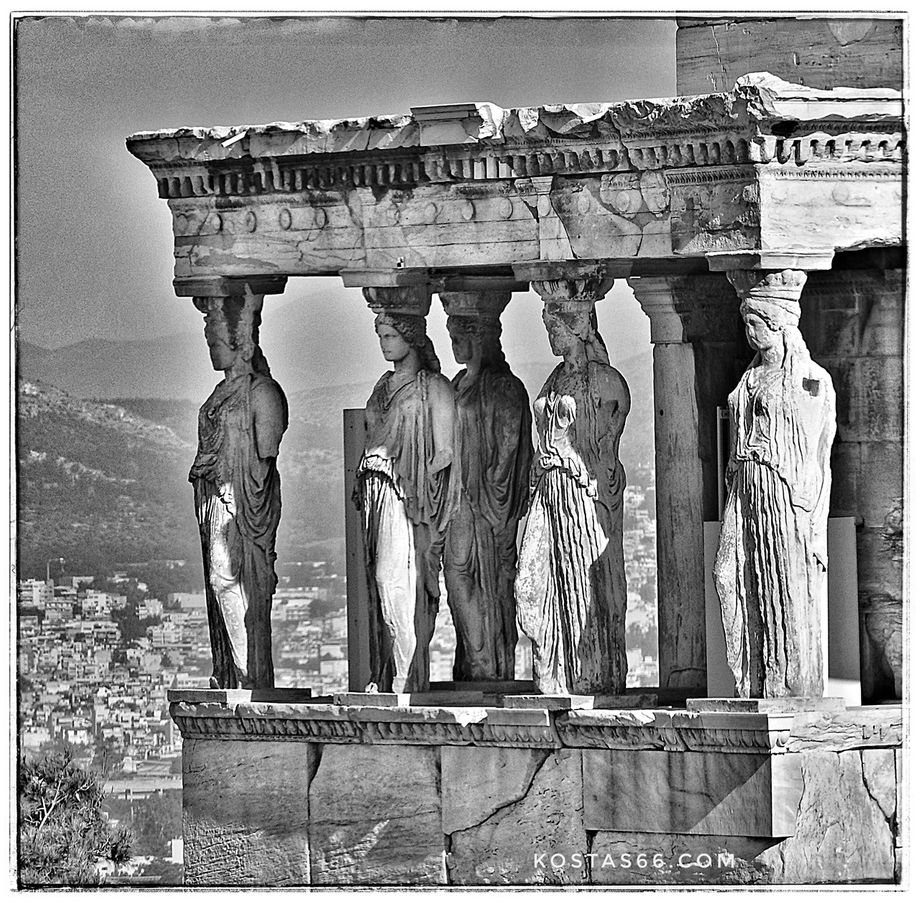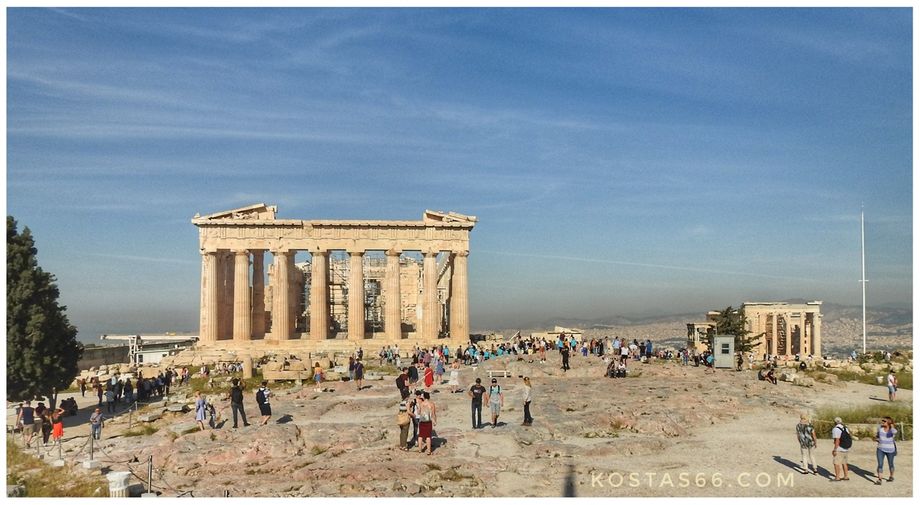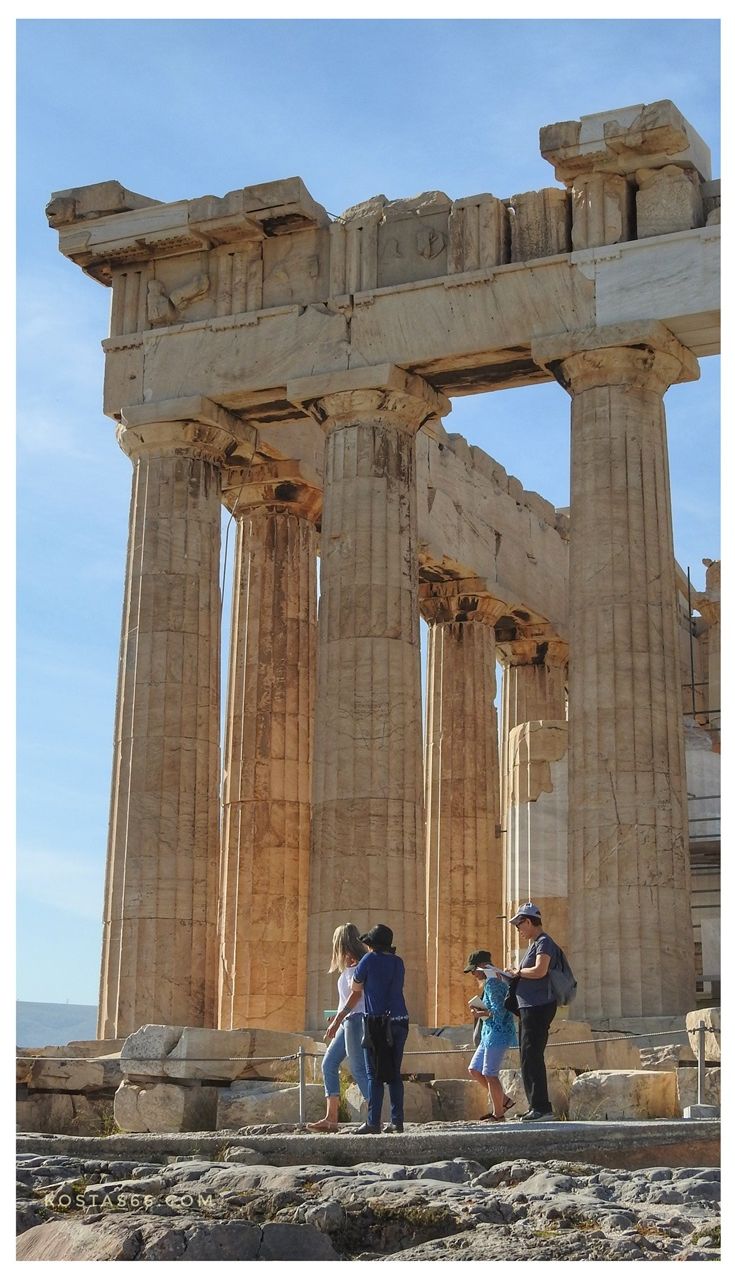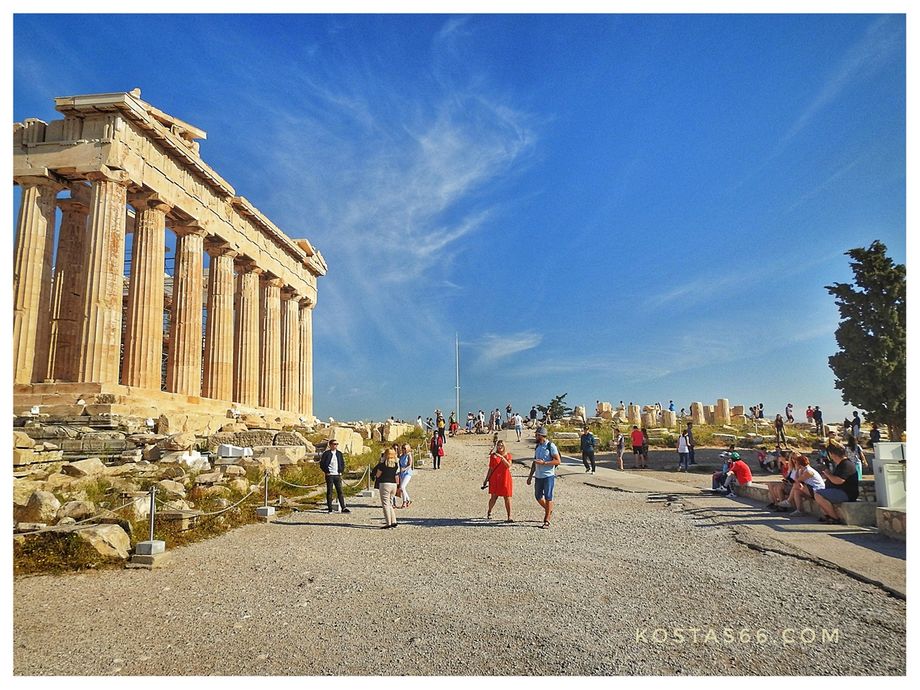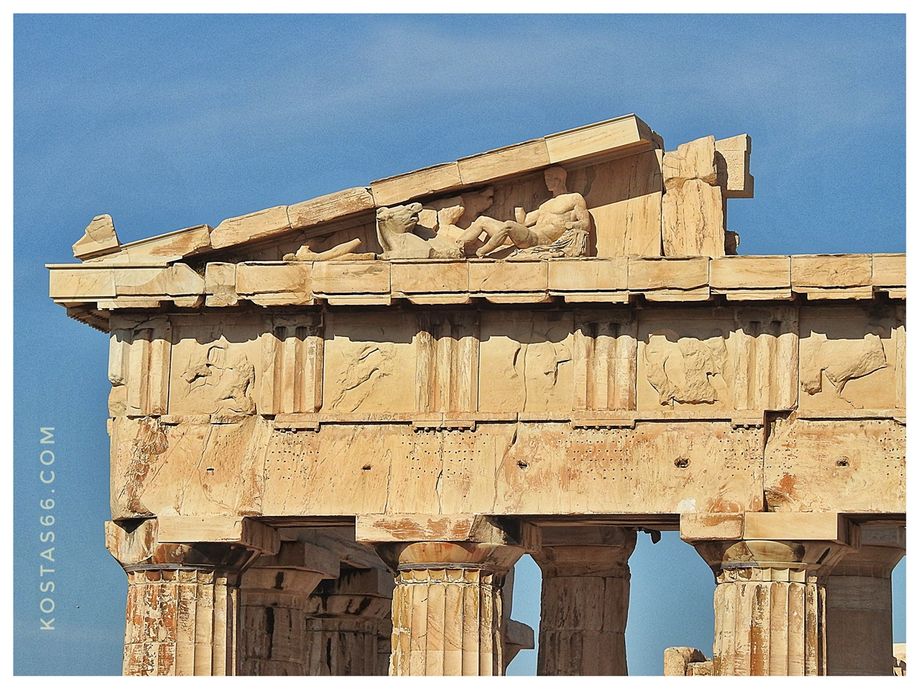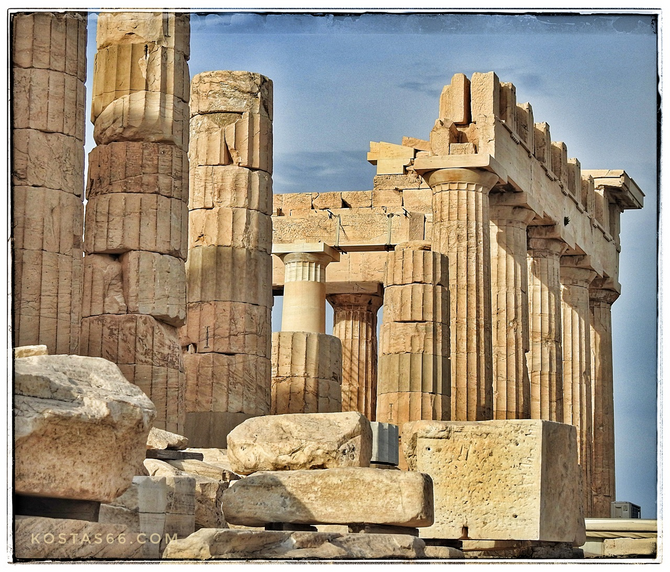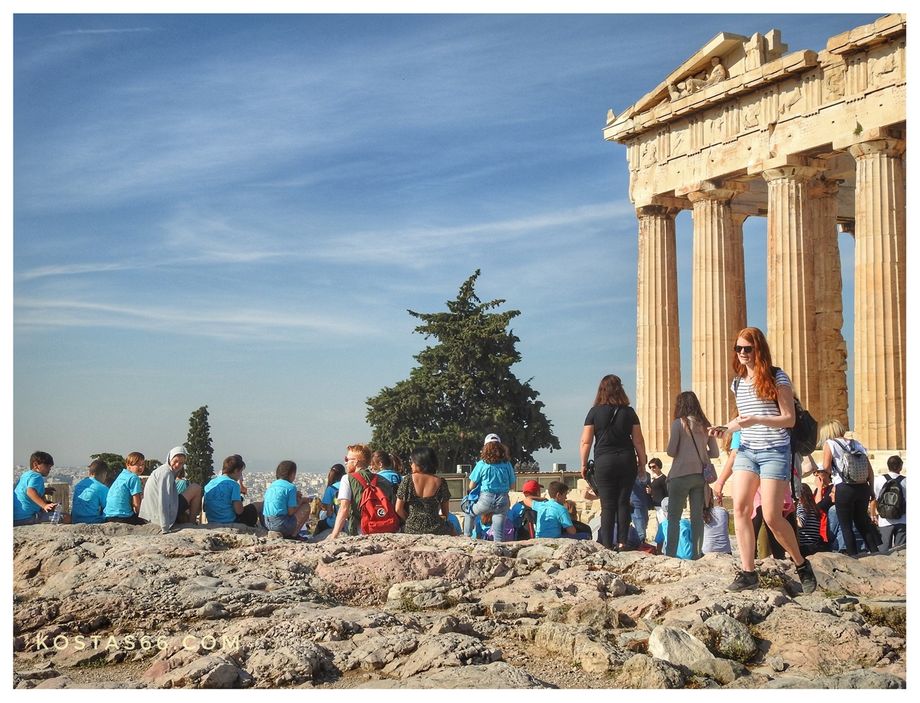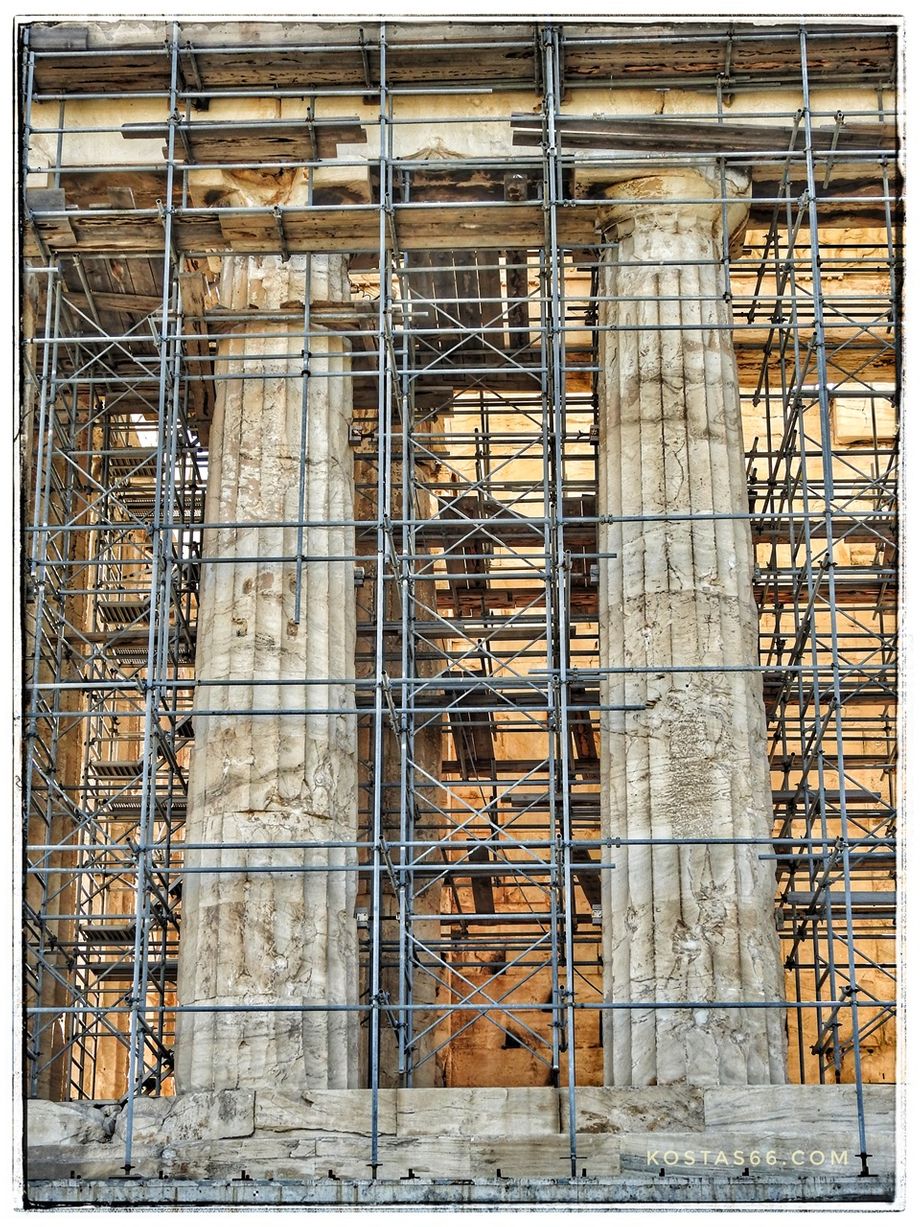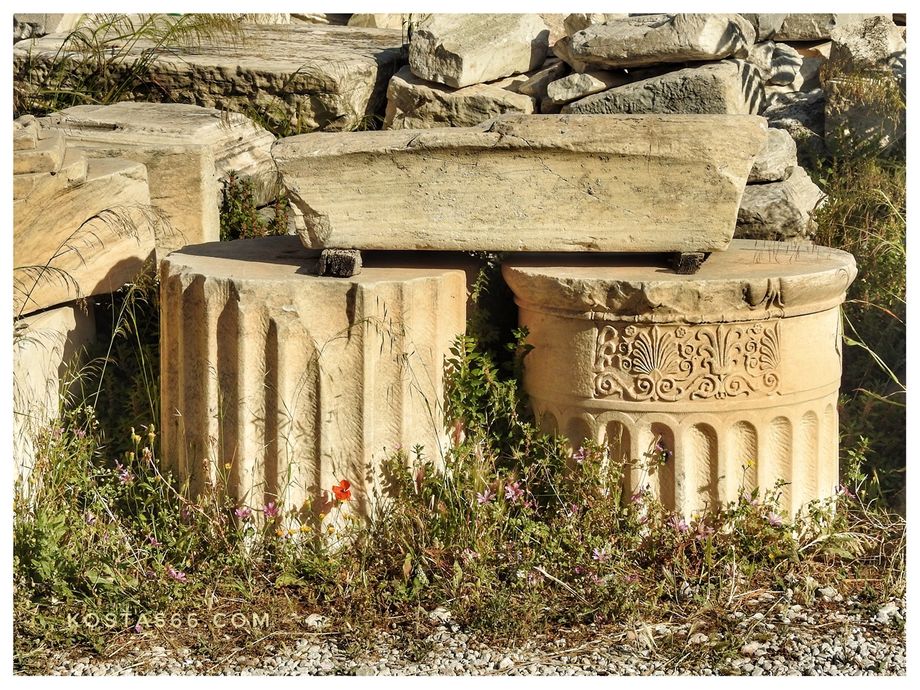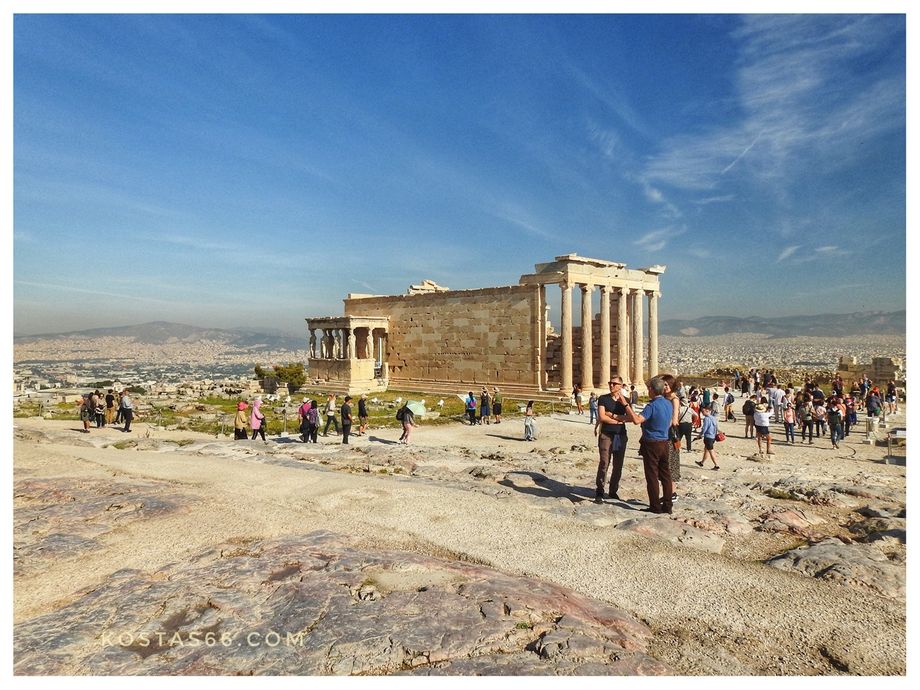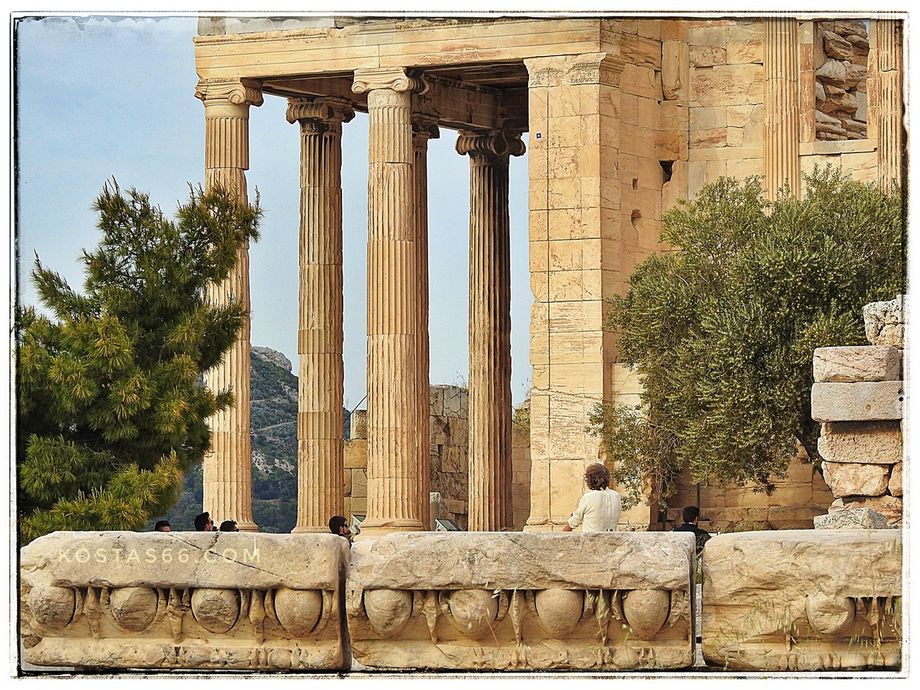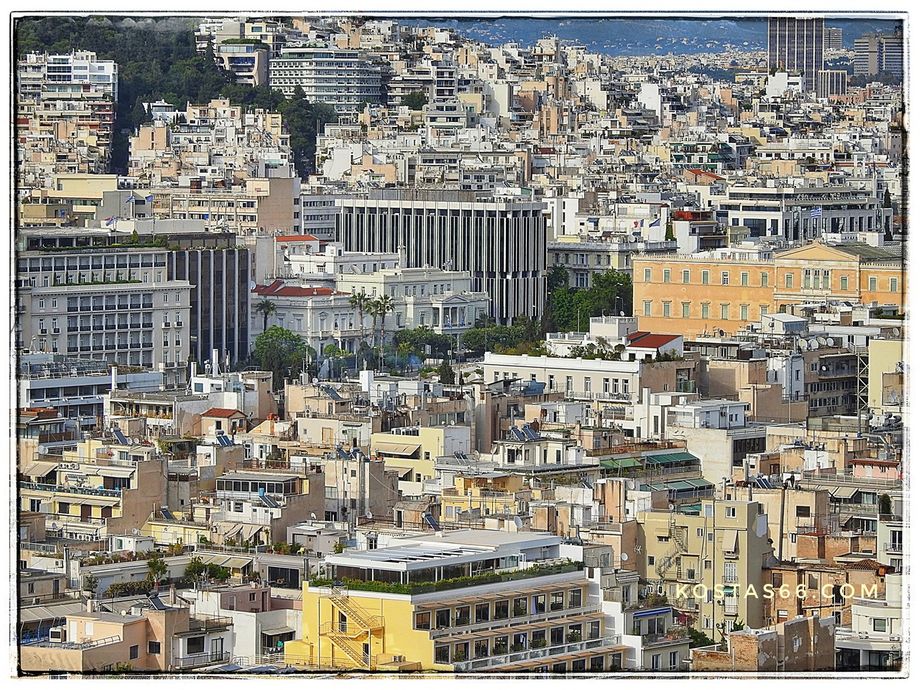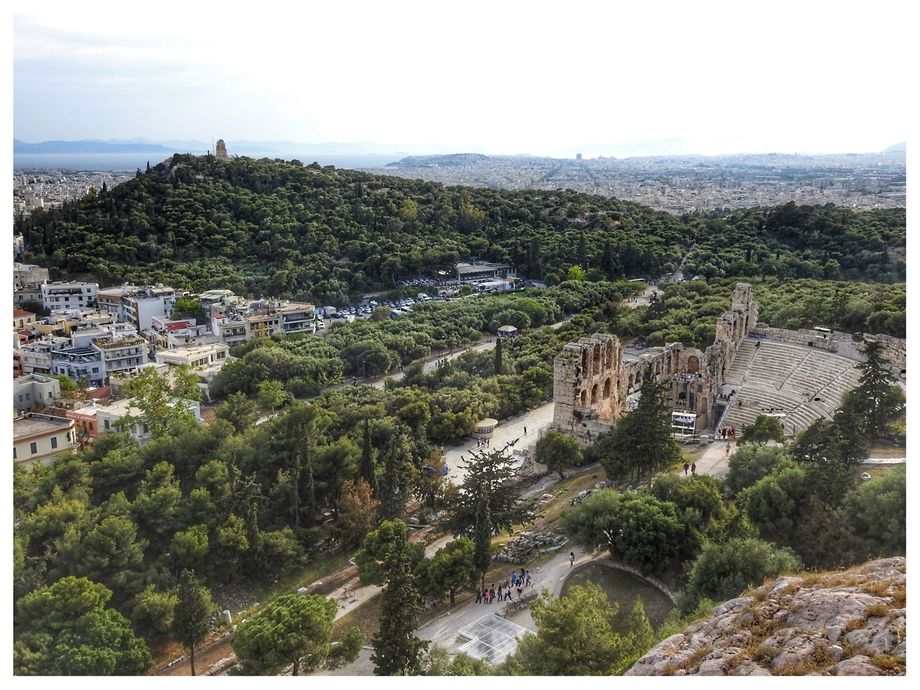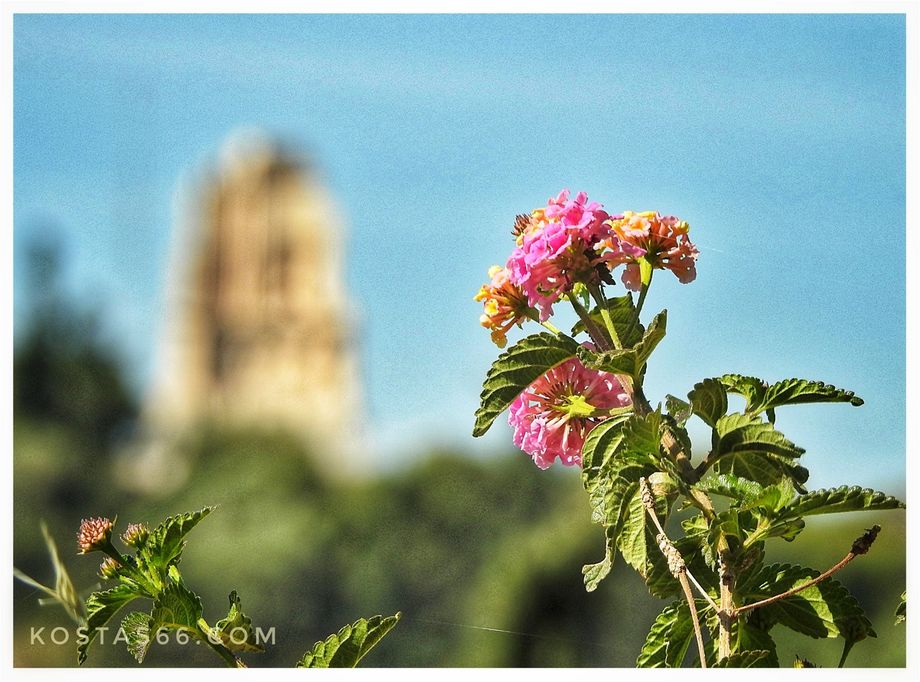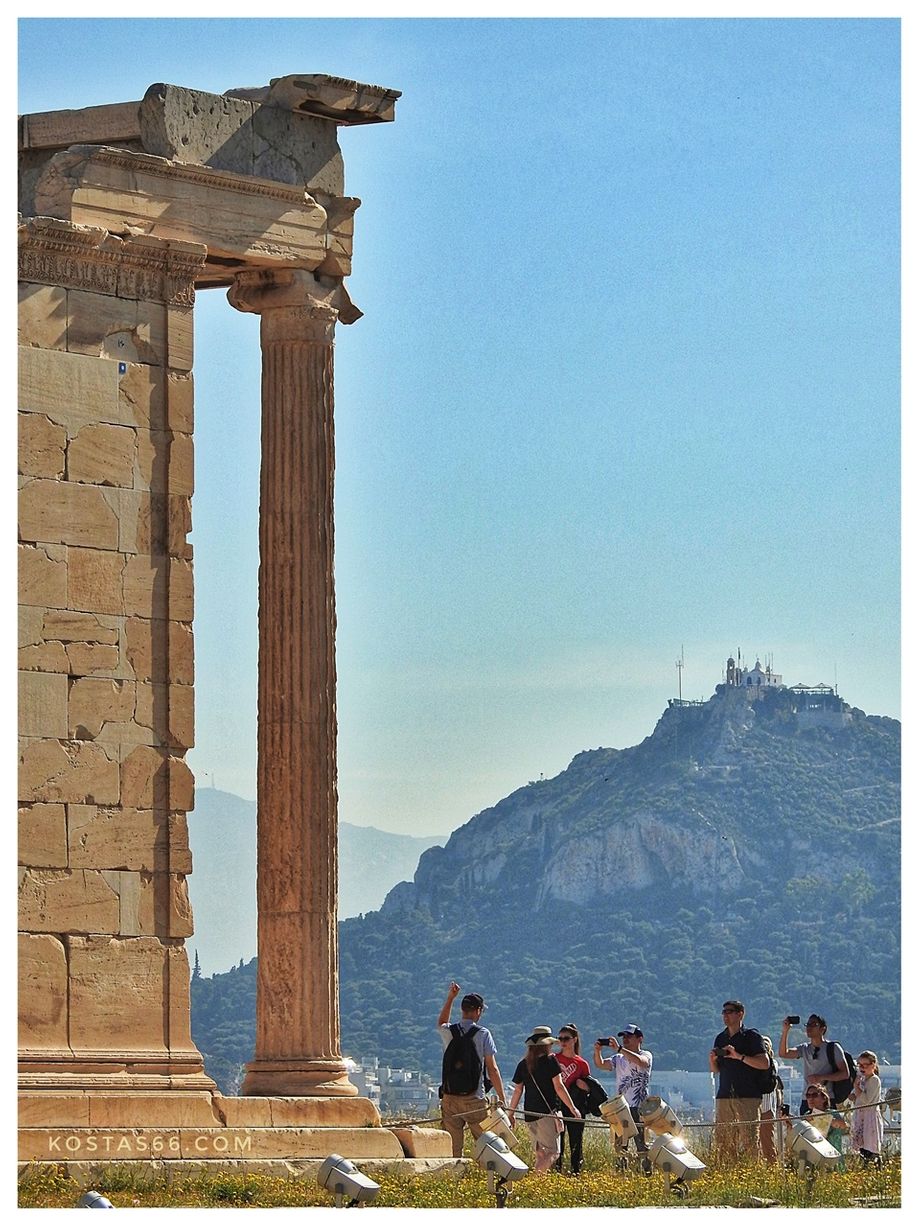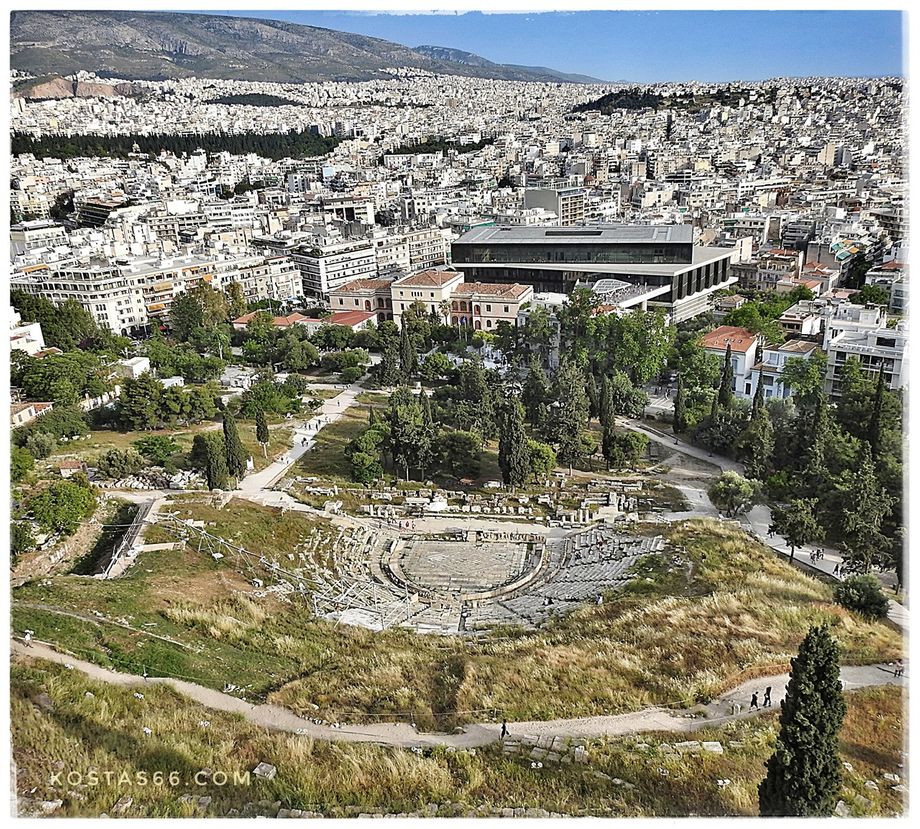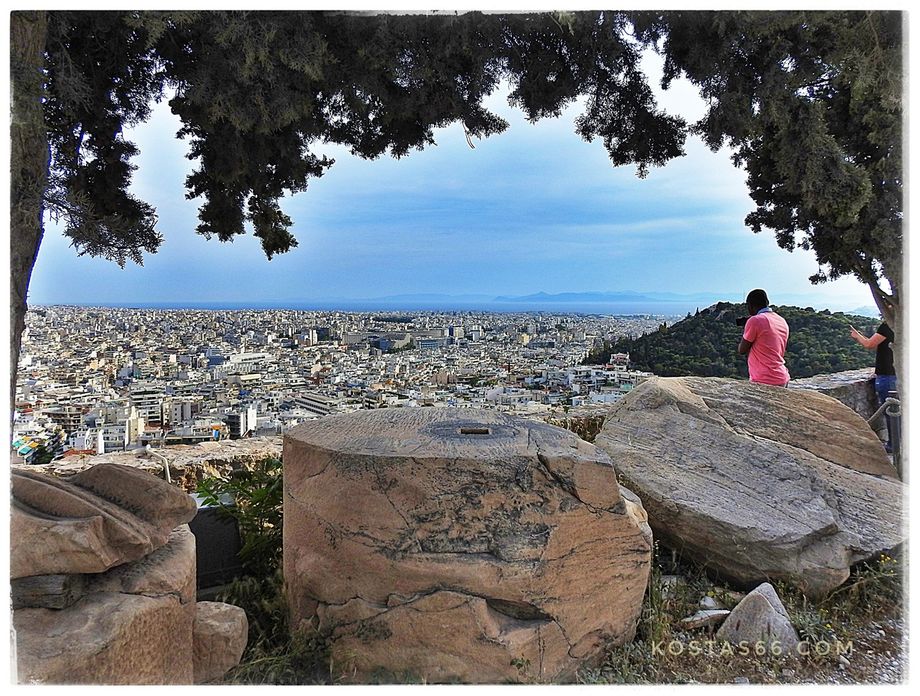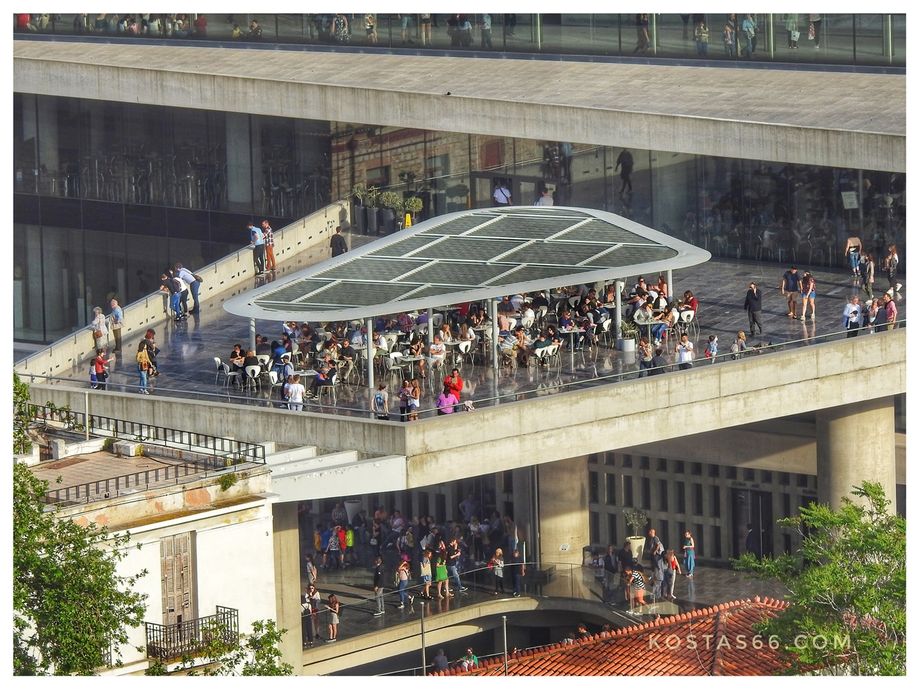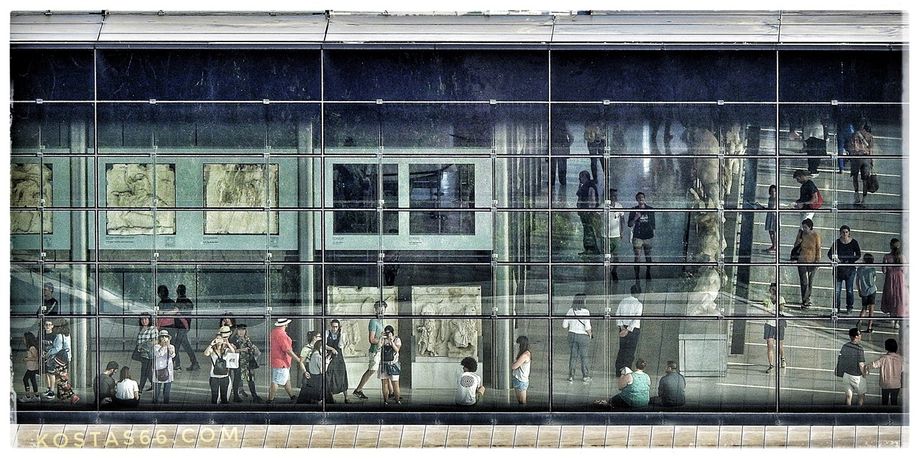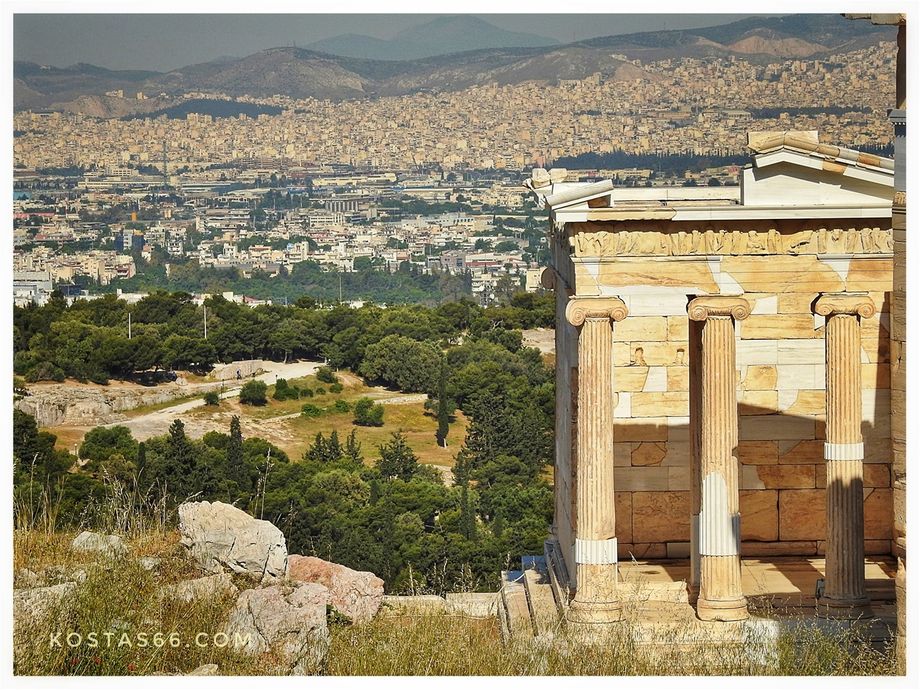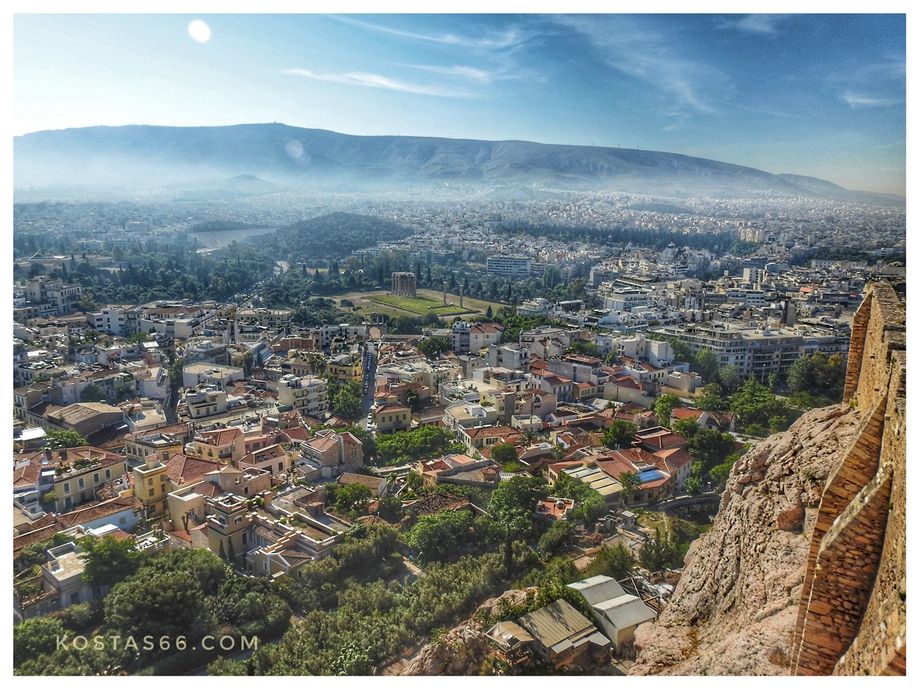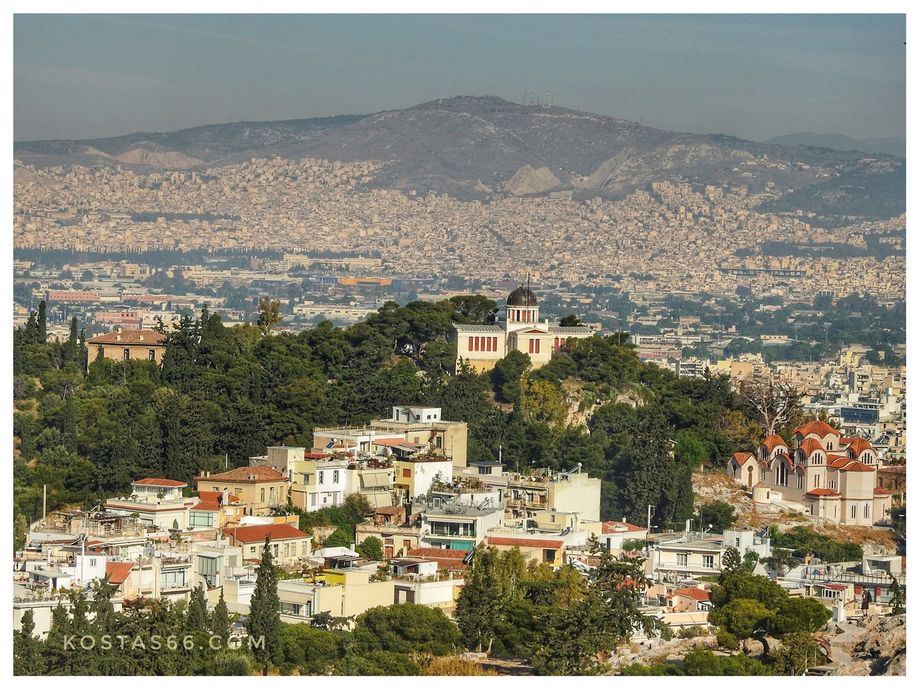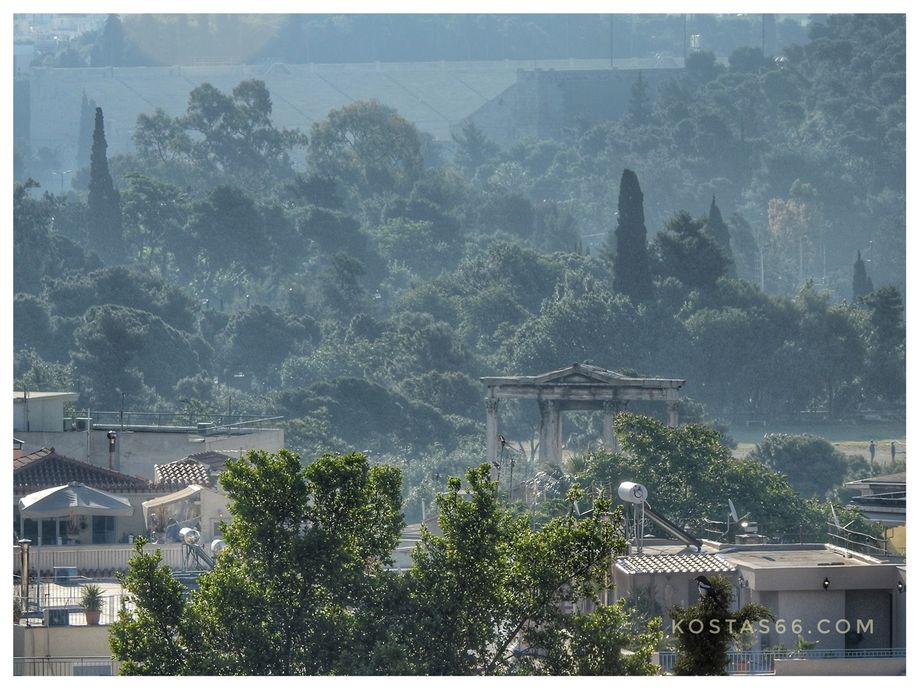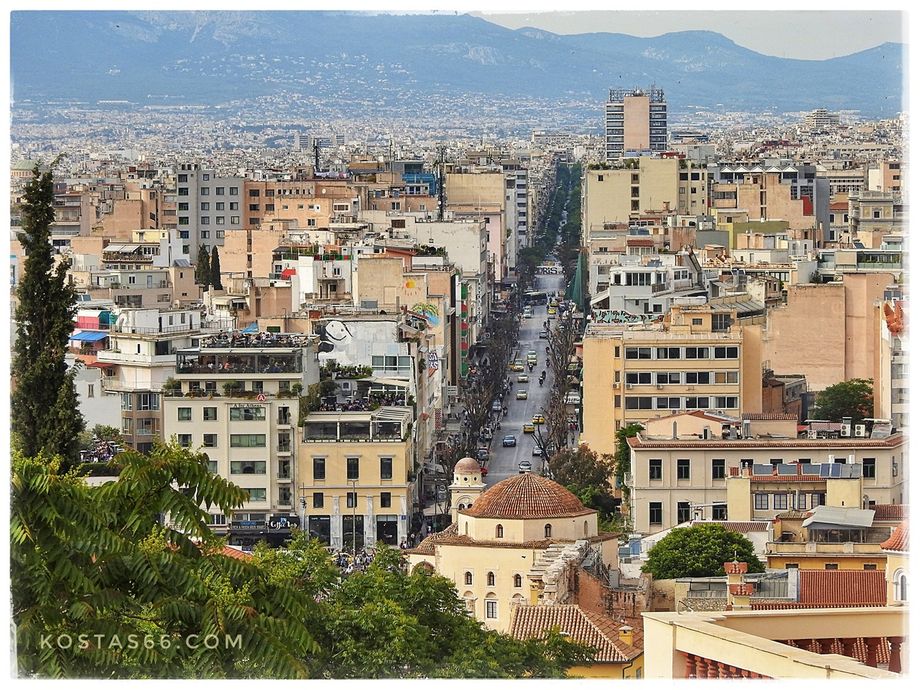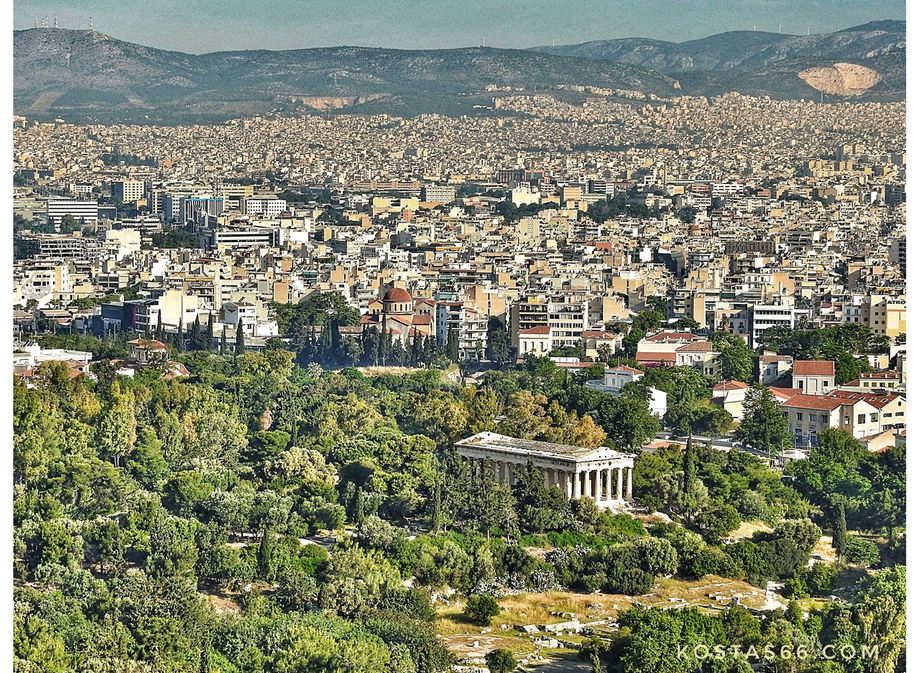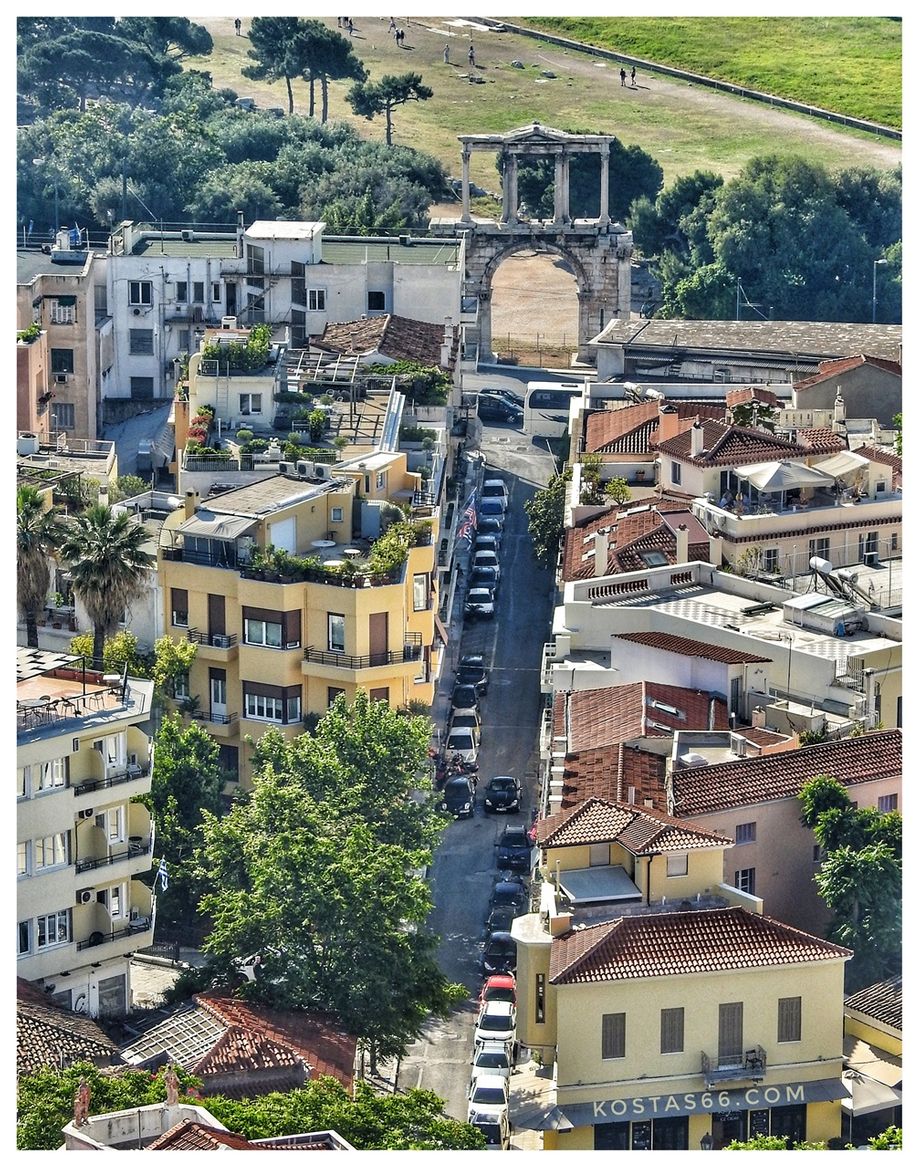theAcropolis of Athens
A Photo album
The importance of Acropolis and its high worldwide symbolism is undisputable. It is maybe the most recognizable landmark globally, and UNESCO has chosen it as its hallmark. Therefore, there is nothing that has not been written or narrated about Acropolis.
The information available is overwhelming, so I am sure I could not add anything more. Therefore, besides giving some practical information, the main purpose of this article is to present the plethora of pictures I took recently on and around the "sacred rock".
Acropolis is "omnipresent" and can be seen from almost everywhere in the city of Athens.
Acropolis can be seen almost from everywhere in the city. View from "A for Athens" rooftop cafe at Monastiraki Square.
The east part of Acropolis (picture taken from Lysikratous street). The Choragic Monument of Lysicrates seen on the right.
The SE side of the Acropolis seen from the cafe of the Marks & Spencer store on Ermou street.
The west side of the sacred rock. Picture taken from Apostolou Pavlou street.
East part of Acropolis seen from the open air cinema "Cine Paris" on Kidathineon street.
Acropolis from Aeropagus Hill.
Acropolis seen from Thysio.
The Acropolis archeological site
The archeological site of Acropolis is a vast area, which includes not only the 156m-high rock but also the surrounding area. It has several entrances, but only two of them are functional throughout the year. Of these two, the first (the main entrance) is located at the western part and the second at the southeastern part of the hill, opposite the New Acropolis Museum (on the pedestrian Dyonisiou Areopagitou Ave). The entrance fee is 20€, so I always check my calendar for the free entrance days throughout the year (some holidays and feasts) to go there.
The yellow line shows the limits of the archaeological site of Acropolis. The red line shows my proposed path, which includes most monuments. The two red arrows show the entrances to the site, while the light green one the entrance to the sacred rock.
The best way (or at least what I recommend) to explore the archeological site is to enter from the southeastern entrance.
First, wander around the south slope, which hosts the most important sites outside the Acropolis fortification itself (aka "Ιερός βράχος" or "Sacred Rock"), and then head for a walk around the north hill slope. This walk brings you to the main entrance to the Acropolis sacred rock. For the rest of your visit, you can spend on the rock admiring the antiquities and the panoramic views of Athens.
Acropolis South Slope
Acropolis (south slope) seen from Filopappou Hill.
The south slope of Acropolis (picture taken from inside the archaeological site).
The South Slope (Νότια Κλιτύς), the sunniest side of the Acropolis Hill, played a significant role in the artistic, intellectual and religious activity of ancient Athens. It was here the Athenians built the theatre where the ancient Greek drama was born: the Theater of Dionysus (Θέατρο Διονύσου). Visitors can enter the theater and sit at the cavea. Some centuries later, the Romans built the Odeon of Herodes Atticus (Θέατρο Ηρώδη Αττικού, aka Ηρώδειο), which still lies at the heart of the city's cultural life. The Odeon can not be visited as part of the archeological site, but only during one of the shows held here during the summer months. In any case, one can see the full splendor of the Odeon from above. The two theaters monopolize the interest of most visitors, but these are not the only buildings here. The Stoa of Eumenes II, king of Pergamon, was an imposing building running along the hill's foot, the ruins of which can still be seen. Its counterpart is to be found in the stoa his brother Attalus erected in Athens's ancient agora. Other buildings of interest in the south slope are the: Byzantine cistern (Βυζαντινό Υδραγωγείο), the Temple of Asclepios (Ναός του Ασκληπιού), and the Temple of Themis. The Choragic Monument of Thrasyllos (Χορηγικο Μνημείο Θρασύλλου, aka Παναγία η Σπηλιώτισσα), build at a high altitude just under the walls, has just been restored and looks impressive from the outside. Unfortunately, it is not open to the public, and the people I asked there did not have any idea if it will open to the public at some point.
The ruins of the Stoa of Eumenes II.
Stoa of Eumenes II and the Odeon of Herodes Atticus at the background.
The Choragic Monument of Thrasyllos.
The front (entrance) of the Odeon of Herodes Atticus. This part is outside the archeological site of the Acropolis and can be accessed free of charge at any time of the day. This is the entrance to the Odeon for the shows staged here during the summer months.
Odeon of Herodes Atticus during a show rehearsal.
Part of the cavea of the Odeon of Herodes Atticus.
Part of the cavea and the orchestra of the Theater of Dionysus.
Theatre of Dionysus. Part of the Roman stage building (what is left of it).
Theatre of Dionysus Eleuthereus. Statue of a kneeling satyr from the Roman stage building.
The eastern passage of the theater of Dionysus and a copy of the statue of poet Menandros.
Theater of Dionysus seating.
Ηermai placed in a small covered patio next to the Byzantine Cistern. Hermai were sculptures with a head, and perhaps a torso, above a plain, usually squared lower section, on which male genitals may also be carved at the appropriate height. It was believed that they could ward off harm or evil, an apotropaic function, and were placed at crossings, country borders and boundaries as protection, in front of temples, near to tombs, outside houses, etc.
The Temple of Asclepios.
Acropolis North Slope
Acropolis North Slope. The photograph has been taken from one of the numerous rooftop bars in the Plaka-Monastiraki-Thiseion area.
The North Slope of the Acropolis (Βόρεια Κλιτύς) was home to several sanctuaries, which played a vital role in the religious lives of the ancient Athenians, but much simpler in nature. These are places where divinities of nature, fertility, and healing were worshiped on a less monumental and more personal level. Because of these sanctuaries' simplicity, some consider that the north slope is of no importance to the tourist! I can't entirely agree, but, even in this case, it is worth following the well-designed path, from which one has interesting views over Anafiotika and the rooftops of Plaka.
The most curious tourist will discover many shrines nestled among the cliffs, caves, and pathways. The first sanctuary the visitor sees, just after leaving the south slope, is the Sanctuary of Aglauros, inside the city's largest cave. According to Herodotos, it was from here that the Persians invaded the Acropolis in 480 BC. Aglauros was the daughter of the mythical king Kekrops, and it was she who jumped from the Acropolis to save Athens from an extended siege, as the oracle of Delphi dictated. There is no access to the interior of the cave.
Further to the north, Eros and Aphrodite had an open-air sanctuary. Numerous rock-cut niches provide evidence for other shrines for the dedication and display of offerings to deities.
Below the Erechtheion lies the Mycenaean Fountain's cave, which took its name from the fountain built by the Mycenaeans when they built the first fortification of the Acropolis. Most probably, here was the sanctuary of the goddess Ersis, daughter of the King Kekrops and sister of Aglauros. It was located within a natural crack and was only accessible through an invisible staircase.
There are three caves at the northwest corner, where Apollo, Pan, and Zeus were worshiped. Beneath the three caves, we see the slab-paved court of Klepsydra Spring, the most important of all the springs of Acropolis. The entrance to the spring is located on the sacred rock, behind the pedestal of Agrippas. From there, a long stairway leads to the spring and the underground chapel of Agioi Apostoloi.
These sacred spots were connected by an ancient path, called the Peripatos, that circled the Acropolis.
The north slope of Acropolis seen from Aiolou street (Monastiraki/Plaka).
Here in the lush vegetation of the north slope, the visitor can also see the ruins of the church of Saint Nikolaos. The church, which was probably built in the first period of Turkish domination (1458-1687), was of the cross-in-square type with a dome supported on four monolithic columns with bases and capitals of the Ionic order in second use, while the floor was paved with stone slabs. Only part of its walls survives today and the recently restored marble entrance.
The path that leads from the south to the north slope of the Acropolis.
The Sanctuary of Aglauros is inside the largest cave in the city of Athens. Picture taken from the Hadrian's Arch, located at some distance to the east.
North-East slope: looking up to the sacred rock.
Evidence for other shrines is provided by numerous rock-cut niches for the dedication and display of offerings to deities.
The north walls have incorporated older parts of shrines and temples.
The north walls of the sacred rock.
The path around the north slope of Acropolis.
The Church of Saint Nikolaos.
The pedestal of Agrippas seen from the northwest part of the walk around the north slope of the Acropolis.
The south Acropolis slope seen from Cafe Avissinia (Avissinia Square, Monastiraki).
The sacred rock of Acropolis
Propylaia in the night. Photo taken from Aeropagus Hill.
The sacred rock is a citadel whose walls we see today was erected after the Persian Wars in the first half of the 5th century BC, under Themistokles (north wall) and Kimon (south wall). Alterations were made under Perikles and again in later times when the Acropolis became the stronghold of the city. The sacred rock is approached from the West through the Beule gate.
The visitor then approaches the Propylaia (Προπύλαία), the monumental entrance to the fortified sanctuary, built in Classical times by architect Mnesikles. The very well-preserved Temple of Athena Nike (Ναός Αθηνάς Νίκης), built in 420 BC by Kallikrates, dominates the bastion to the south of the Propylaia. Opposite the north wing of the Propylaia stands the tall rectangular pedestal of Agrippas, which once supported an offering by Athens's city to Marcus Agrippas, son-in-law of Augustus.
Propylaia and the Temple of Athena Nike seen from "Dionysos Zonar's" cafe.
Propylaia.
The Beule gate and the Propylaia in the background.
Propylaia.
The temple of Athena Nike on its pedestal, seen from the west.
The pedestal of Agrippas.
Propylaia and Temple of Athena Nike seen from Thyseion.
Propylaia columns (in the foreground) and the Temple of Athena Nike (in the background)..
Propylaia.
The Temple of Athena Nike seen from "Dionysos Zonar's" cafe.
Through the Propylaia, one enters the sanctuary itself properly with its great masterpieces of ancient Greek architecture built primarily in the fifth century under Perikles. The most important of them all is the Parthenon (Παρθενώνας), a temple dedicated to Athena Parthenos, which replaced two earlier temples dedicated to the same goddess.
On the north side of the hill is the Erechtheion (Ερέχθειο), the Ionic temple of Athena and Poseidon-Erechtheus with its famous porch of the Karyatides. This is the place where the olive tree offered Athens to the people of Athens used to be. Today, an olive tree is growing by the temple's west wall, but I do not believe that this is the original one (😀😀😀). At the tallest bastion, located on the rock's east side, stands the pole with the Greek flag. From here, you have the best views of the Athens basin. On a clear day, you can see forever!
The Erechtheion.
The Erechtheion.
Erechtheion.
The Karyatides of the Erechtheion Temple.
Parthenon (left) and Erechtheion (right)
Parthenon.
The east side of the Parthenon. The ruins on the right side of the picture belong to the "Temple of Rome and Augustus" (end of 1st century BC).
Detail of the Parthenon. Part of the east pediment.
The south side of the Parthenon.
The east side of the Parthenon.
The west side of the Parthenon under scafolding.
The Erechtheion.
The Erechtheion. The little olive tree on the right is where supposed to be the original tree goddess Athena donated to the city of Athens.
The views from the Acropolis
(north-east of the sacred rock). The Greek Parliament (the yellow building on the middle-right).
(South-east from the sacred hill). Filopappos Hill and its monument of the same name (left) and Odeon of Herodes Atticus (right).
Philopappos Monument at the background. Picture taken from the sacred rock.
View of Lycabetus Hill from Erechtheion.
The Theater of Dionysus and the Acropolis museum seen from the sacred rock.
The southern suburbs of Athens photographed from the sacred rock.
(south of the sacred rock): The Acropolis Museum.
The upper part of the Acropolis Museum photographed from the sacred rock of Acropolis.
"Elaionas" district of Athens seen from the sacred rock. On the right stands the Temple of Athens Nike.
View towards Mount Hymettos (east of the Acropolis). Can be seen, among others, the Temple of Olympian Zeus and the Panathenaic Stadium behind it.
The National Observatory of Athens, west of the Acropolis.
Hadrian's Arch and the Panathenaic Stadium (east of the Acropolis).
Athinas street. North of the sacred rock.
(North-west of the sacred rock). Ancient Agora of Athens (foreground). Temple of Hephaestus (left).
(East of the sacred rock) Lisikratous street and Hadrian's Arch.

